Effects of Local Denting and Fracture Damage on the Residual Longitudinal Strength of Box Girders
Abstract
:1. Introduction
2. Test Models
2.1. Dimensions of the Test Models
2.2. Material Properties
2.3. The Initial Shape-Imperfection Measurement
3. Collision Tests
4. Residual Longitudinal Strength Tests
4.1. The Experimental Setup
4.2. Bending Tests
4.3. Bending Test Results
5. Numerical Analysis
5.1. FE Modeling
5.2. Definitions of Material Properties
5.3. Collision Simulations
5.4. Bending Simulations
6. Discussion
6.1. Frictional Force Estimation
6.2. The Comparison of the Predicted Ultimate Bending Moment
6.3. The Residual Strength of the Damaged Model
7. Conclusions
- -
- The numerical analysis technique adopted in this study can be a reference for future simulations predicting the collision damage and residual bending strength;
- -
- When performing longitudinal bending tests, it is necessary to experimentally obtain frictional forces between the test model and the supports.
Author Contributions
Funding
Institutional Review Board Statement
Informed Consent Statement
Conflicts of Interest
References
- International Association of Classification Societies (IACS). Common Structural Rules for Bulk Carriers and Oil Tankers; International Association of Classification Societies (IACS): London, UK, 2022. [Google Scholar]
- Sugimura, T.; Nozaki, M.; Suzuki, T. Destructive experiment of ship hull model under longitudinal bending. J. Soc. Nav. Archit. Jpn. 1966, 119, 209–220. [Google Scholar] [CrossRef]
- Dowling, P.J.; Moolani, F.M.; Frieze, P.A. The effect of shear lag on the Ultimate strength of Box girders. In Proceedings of the International Congress on Steel Plated Structures, London, UK, 20–21 July 1976; Imperial College: London, UK; pp. 108–147. [Google Scholar]
- Reckling, K.A. Behaviour of box girders under bending and shear. In Proceedings of the 7th International Ship and Offshore Structures Congress (ISSC), Paris, France, August 1979; pp. 46–49. [Google Scholar]
- Nishihara, S. Analysis of ultimate strength of stiffened rectangular plate. J. Soc. Nav. Archit. Jpn. 1983, 154, 367–375. [Google Scholar] [CrossRef] [PubMed]
- Mansour, A.E.; Yang, J.M.; Thayamballi, A. An Experimental Investigation of Ship Hull Ultimate Strength. Trans. SNAME 1990, 98, 411–439. [Google Scholar]
- Dow, R.S. Testing and analysis of 1/3-scale welded steel frigate model. In Proceedings of the 2nd International Conference on Advances in Marine Structures, Dunfermline, Scotland, UK, 21–24 May 1991; pp. 749–773. [Google Scholar]
- Paik, J.K.; Amlashi, H.; Boon, B.; Branner, K.; Caridis, P.; Das, P.; Fujikubo, M.; Huang, C.-H.; Josefson, L.; Kaeding, P.; et al. Committee III.1 Ultimate strength. In Proceedings of the 18th International Ship and Offshore Structures Congress (ISSC), Rostock, Germany, 10–13 September 2012; Volume 1, pp. 285–363. [Google Scholar]
- Akhras, G.; Gibson, S.; Yang, S.; Morchat, R. Ultimate strength of a box girder simulating the hull of a ship. Can. J. Civ. Eng. 1998, 25, 829–843. [Google Scholar] [CrossRef]
- Qi, E.R.; Cui, W.C.; Wan, Z.Q. Comparative study of ultimate hull girder strength of large double hull tankers. Mar. Struct. 2005, 18, 227–249. [Google Scholar] [CrossRef]
- Yao, T.; Fujikubo, M.; Yanagihara, D.; Fujii, I.; Matrui, R.; Furui, N.; Kuwamura, Y. Buckling collapse strength of chip carrier under longitudinal bending (1st Report)-collapse test on 1/10-scale hull girder model under pure bending. J. Soc. Nav. Archit. Jpn. 2002, 191, 265–274. [Google Scholar]
- Wu, Y.-j.; Wan, Q.; Guo, J.-j. Study on the model of double hull tank for hull ultimate strength experiment. In Proceedings of the 3rd International Conference on Safety and Reliability of Ship, Offshore and Subsea Structures (SAROSS), Wuhan, China, 23–25 May 2018. [Google Scholar]
- Gordo, J.M.; Soares, C.G. Experimental Evaluation of the Ultimate Bending Moment of a Box Girder. Mar. Syst. Ocean Technol. 2004, 1, 33–46. [Google Scholar] [CrossRef]
- Gordo, J.M.; Soares, C.G. Tests on ultimate strength of hull box girders made of high tensile steel. Mar. Struct. 2009, 22, 770–790. [Google Scholar] [CrossRef]
- Gordo, J.M.; Soares, C.G. Experimental analysis of the effect of frame spacing variation on the ultimate bending moment of box girders. Mar. Struct. 2014, 37, 111–134. [Google Scholar] [CrossRef]
- Wang, C.; Wu, J.; Wang, D. Experimental and numerical investigations on the ultimate longitudinal strength of an ultra large container ship. Ocean Eng. 2019, 192, 106546. [Google Scholar] [CrossRef]
- Chen, X.W.; Yuan, H.X.; Real, E.; Du, X.X.; Schafer, B.W. Experimental behaviour of stainless steel plate girders under combined bending and shear. J. Constr. Steel Res. 2020, 166, 105900. [Google Scholar] [CrossRef]
- Zhao, N.; Chen, B.Q.; Zhou, Y.Q.; Li, Z.J.; Hu, J.J.; Soares, C.G. Experimental and numerical investigation on the ultimate strength of a ship hull girder model with deck openings. Mar. Struct. 2022, 83, 103175. [Google Scholar] [CrossRef]
- Saad-Eldeen, S.; Garbatov, Y.; Soares, C.G. Experimental assessment of the ultimate strength of a box girder subjected to severe corrosion. Mar. Struct. 2011, 24, 338–357. [Google Scholar] [CrossRef]
- Saad-Eldeen, S.; Garbatov, Y.; Soares, C.G. Analysis of plate deflections during ultimate strength experiments of corroded box girders. Thin-Walled Struct. 2012, 54, 164–176. [Google Scholar] [CrossRef]
- Saad-Eldeen, S.; Garbatov, Y.; Soares, C.G. Effect of corrosion severity on the ultimate strength of a steel box girder. Eng. Struct. 2013, 49, 560–571. [Google Scholar] [CrossRef]
- Saad-Eldeen, S.; Garbatov, Y.; Soares, C.G. Ultimate strength assessment of corroded box girders. Ocean Eng. 2013, 58, 35–47. [Google Scholar] [CrossRef]
- Saad-Eldeen, S.; Garbatov, Y.; Soares, C.G. Strength assessment of a severely corroded box girder subjected to bending moment. J. Constr. Steel Res. 2014, 92, 90–102. [Google Scholar] [CrossRef]
- Lee, T.K.; Rim, C.W. An experimental study on the ultimate longitudinal strength of ship structures damaged due to side collision. J. Korean Soc. Mar. Environ. Eng. 2008, 22, 85–90. [Google Scholar]
- Rim, C.W.; Lee, T.K.; Han, D.S.; Kim, B.H.; Lee, J.M.; Kim, K.S. The effect of bottom damage size of stranded ship on ultimate strength. In Proceedings of the 27th International Conference on Ocean, Offshore and Arctic Engineering (OMAE), Estoril, Portugal, 15–20 June 2008. [Google Scholar]
- Yamada, Y.; Takami, T. Model test on the ultimate longitudinal strength of a damaged box girder. In Analysis and Design of Marine Structures; CRC Press: Boca Raton, FL, USA, 2015. [Google Scholar]
- Cho, S.-R.; Yoon, S.-H.; Park, S.-H.; Song, S.-U. Collision damage and residual strength of box girder structures. In Proceedings of the 7th International Conference on Collision and Grounding of Ships and Offshore Structures (ICCGS), Ulsan, Republic of Korea, 21–23 October 2016. [Google Scholar]
- Cho, S.-R.; Park, S.-H.; Cho, M.T.; Shin, H.K. Residual longitudinal strength of damaged box girder structures. In Proceedings of the 37th International Conference on Ocean, Offshore and Arctic Engineering (OMAE), Madrid, Spain, 17–22 June 2018. [Google Scholar]
- KS B 0801; Test Pieces for Tensile Test for Metallic Materials. Korean Standards Association: Seoul, Republic of Korea, 2007.
- Do, Q.T.; Muttaqie, T.; Park, S.-H.; Shin, H.K.; Cho, S.R. Predicting the collision damage of steel ring-stiffened cylinders and their residual strength under hydrostatic pressure. Ocean Eng. 2018, 169, 326–343. [Google Scholar] [CrossRef]
- Do, Q.T.; Muttaqie, T.; Park, S.-H.; Shin, H.K.; Cho, S.-R. Ultimate strength of intact and dented steel stringer-stiffened cylinders under hydrostatic pressure. Thin-Walled Struct. 2018, 132, 442–460. [Google Scholar]
- Faulkner, D. Chapter 21 in Ship structural design concepts. In Compression Strength of Welded Grillage; Evans, J.H., Ed.; Cornell Maritime Press: Cambridge, MD, USA, 1975; pp. 633–712. [Google Scholar]
- Yao, T.; Astrup, O.C.; Caridis, P.; Chen, Y.N.; Cho, S.-R.; Dow, R.S.; Niho, O.; Rigo, P. Special Task Committee VI.2 Ultimate hull girder strength. In Proceedings of the 4th International Ship and Offshore Structures Congress (ISSC), Nagasaki, Japan, 2–6 October 2000. [Google Scholar]
- Cho, S.-R.; Choi, S.I.; Son, S.K. Dynamic material properties of marine steels under impact loadings. In Proceedings of the World Congress on Advances in Structural Engineering and Mechanics (ASEM15), Incheon, Republic of Korea, 25–29 August 2015. [Google Scholar]
- Ringsberg, J.W.; Amdahl, J.; Chen, B.Q.; Cho, S.R.; Ehlers, S.; Hu, Z.; Kubiczek, J.M.; Kõrgesaar, M.; Liu, Q.; Marinatos, J.M.; et al. MARSTRUCT benchmark study on nonlinear FE simulation of an experiment of an indenter impact with a ship side-shell structure. Mar. Struct. 2018, 59, 142–157. [Google Scholar] [CrossRef] [Green Version]
- Yoshikawa, T.; Bayatfar, A.; Kim, B.J.; Chen, C.P.; Wang, D.; Boulares, J.; Gordo, J.M.; Josefson, L.; Smith, M.; Kaeding, P.; et al. Committee III.1 Ultimate strength. In Proceedings of the 19th International Ship and Offshore Structures Congress (ISSC), Lisbon, Portugal, 7–10 September 2015; Volume 1, pp. 279–349. [Google Scholar]
- Czujko, J.; Bayatfar, A.; Smith, M.; Xu, M.C.; Wang, D.; Lützen, M.; Saad-Eldeen, S.; Yanagihara, D.; Notaro, G.; Qian, X.; et al. Committee III.1 Ultimate strength. In Proceedings of the 20th International Ship and Offshore Structures Congress (ISSC), Amsterdam, The Netherlands, 9–14 September 2018; Volume 1, pp. 335–439. [Google Scholar]
- Benson, S.; AbuBakar, A.; Dow, R.S. A comparison of computational methods to predict the progressive collapse behavior of a damaged box girder. Eng. Struct. 2013, 48, 266–280. [Google Scholar] [CrossRef] [Green Version]
- Morshedsoluk, F.; Khedmati, M.R. Ultimate strength of composite ships’ hull girders in the presence of composite superstructures. Thin-Walled Struct. 2016, 102, 122–138. [Google Scholar] [CrossRef]
- Ao, L.; Wang, D.Y. Ultimate torsional strength of cracked stiffened box girders with a large deck opening. Int. J. Nav. Archit. Ocean Eng. 2016, 8, 360–374. [Google Scholar] [CrossRef]
- Underwood, J.M.; Sobey, A.J.; Blake, J.I.R.; Shenoi, R.A. Compartment level progressive collapse strength as a method for analysing damaged steel box girders. Thin-Walled Struct. 2016, 106, 346–357. [Google Scholar] [CrossRef] [Green Version]
- Putranto, T.; Kõrgesaar, M.; Tabri, K. Application of Equivalent Single Layer Approach for Ultimate Strength Analyses of Ship Hull Girder. J. Mar. Sci. Eng. 2022, 10, 1530. [Google Scholar] [CrossRef]
- Li, S.; Kim, D.K. A comparison of numerical methods for damage index based residual ultimate limit state assessment of grounded ship hulls. Thin-Walled Struct. 2022, 172, 108854. [Google Scholar] [CrossRef]
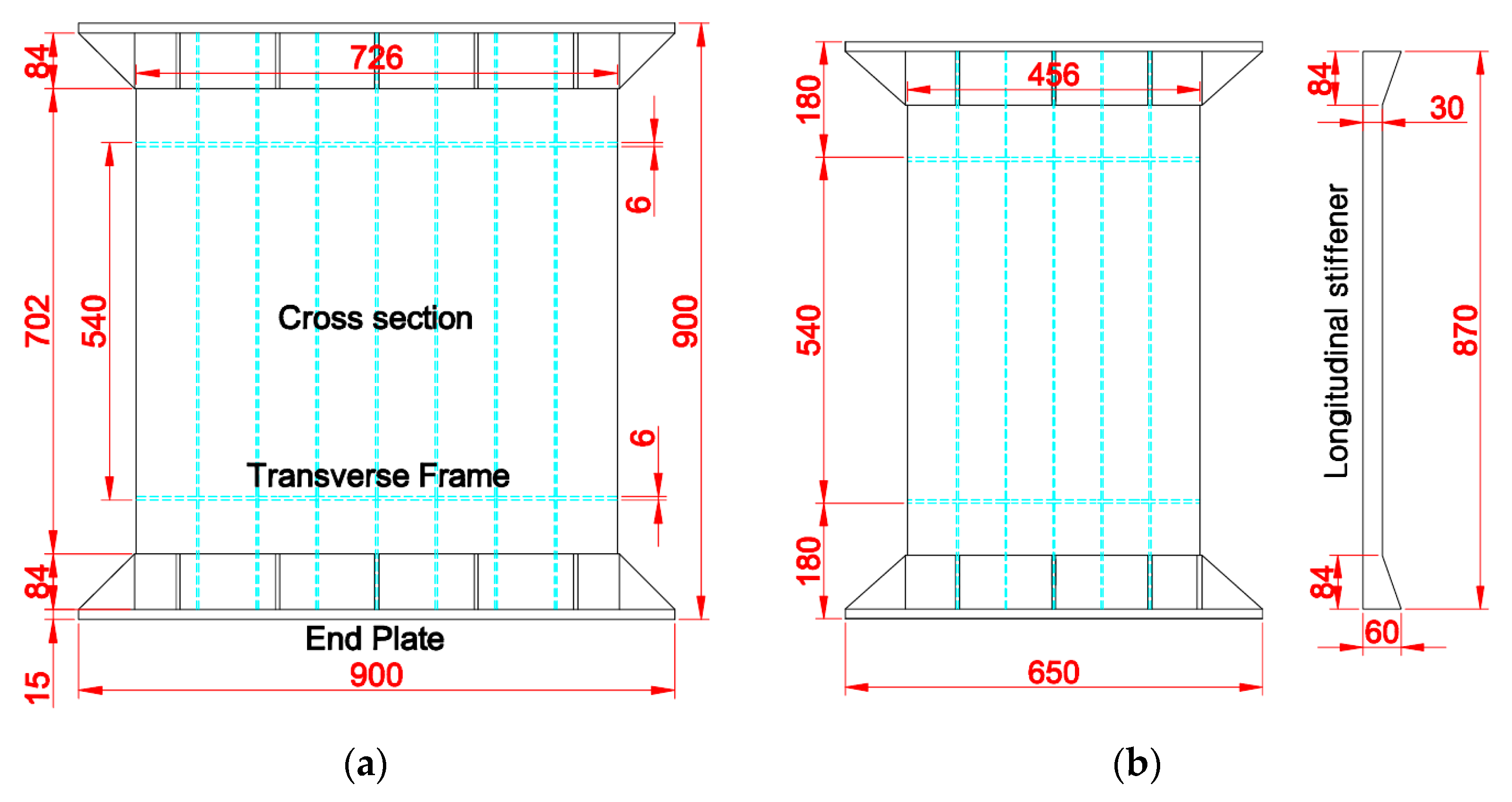
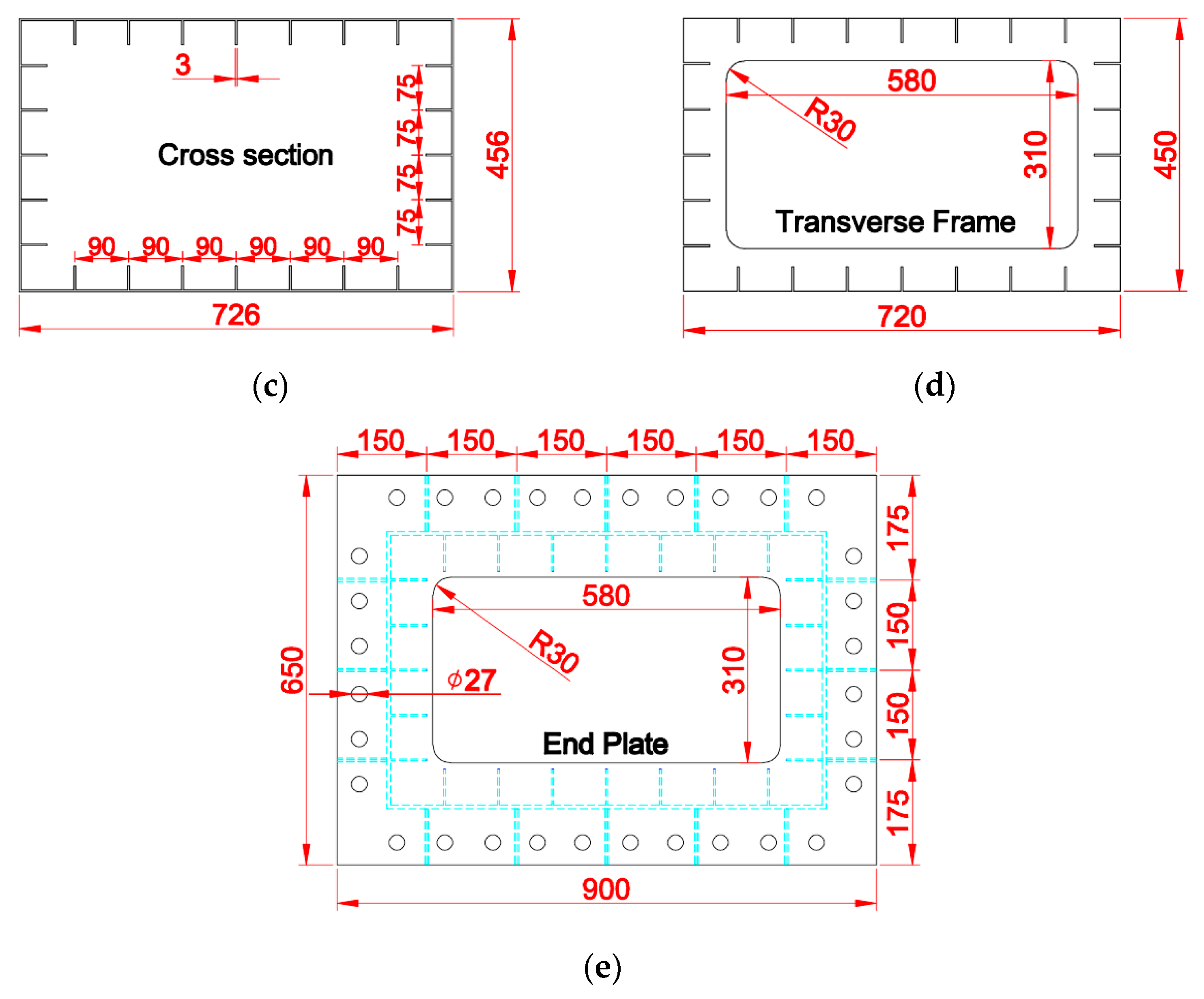
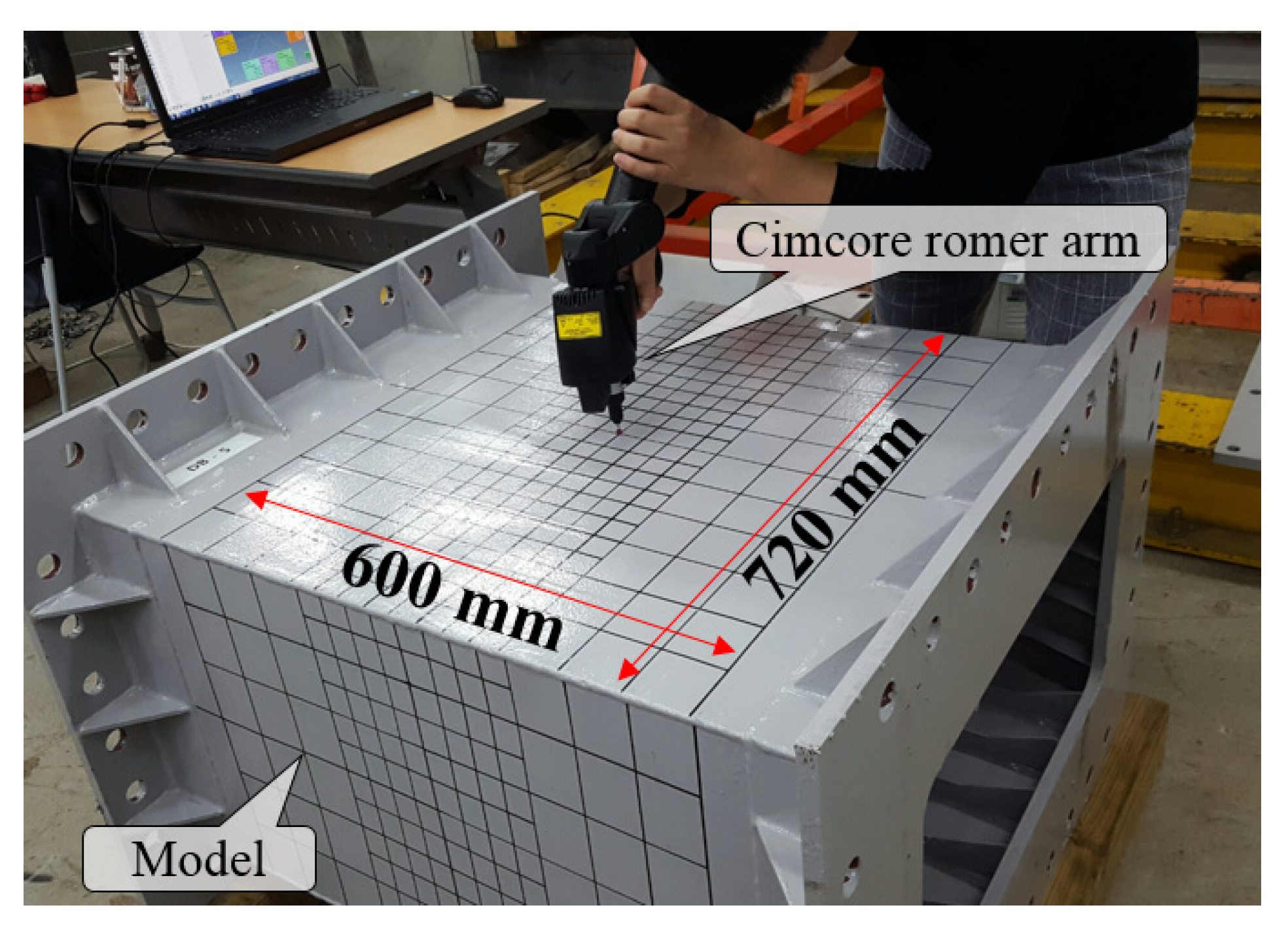
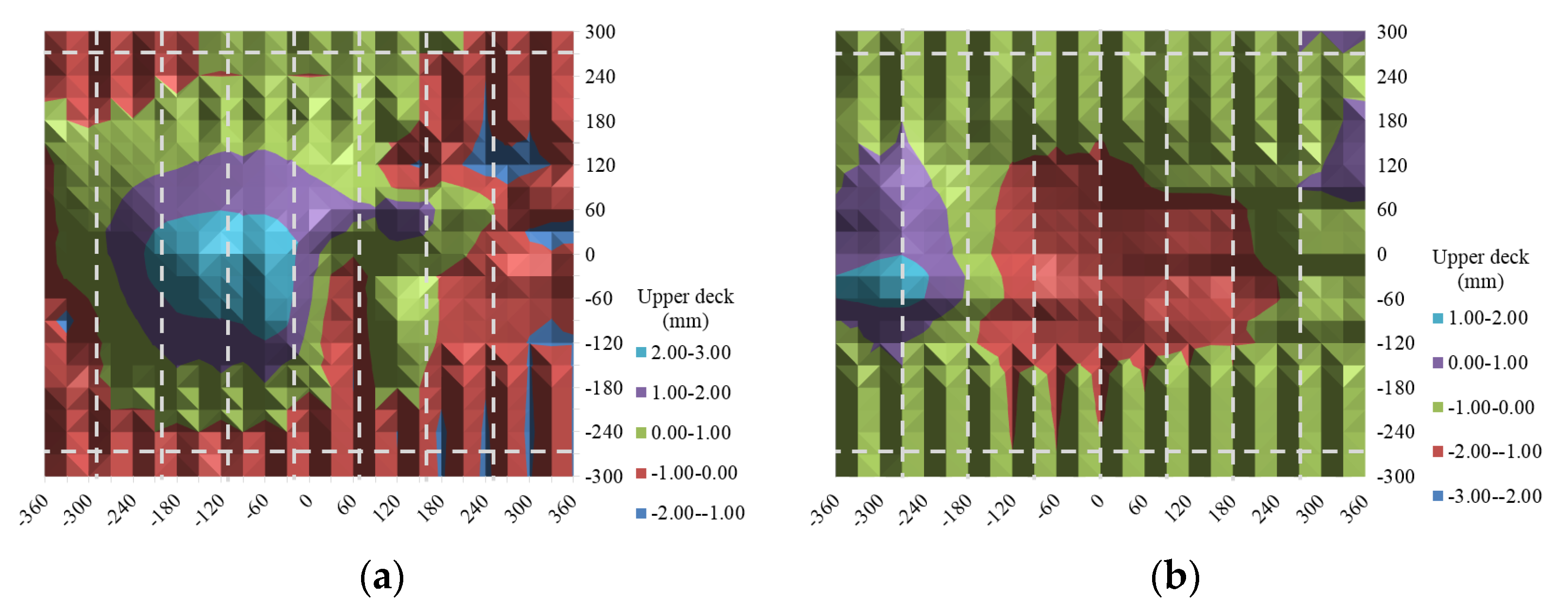
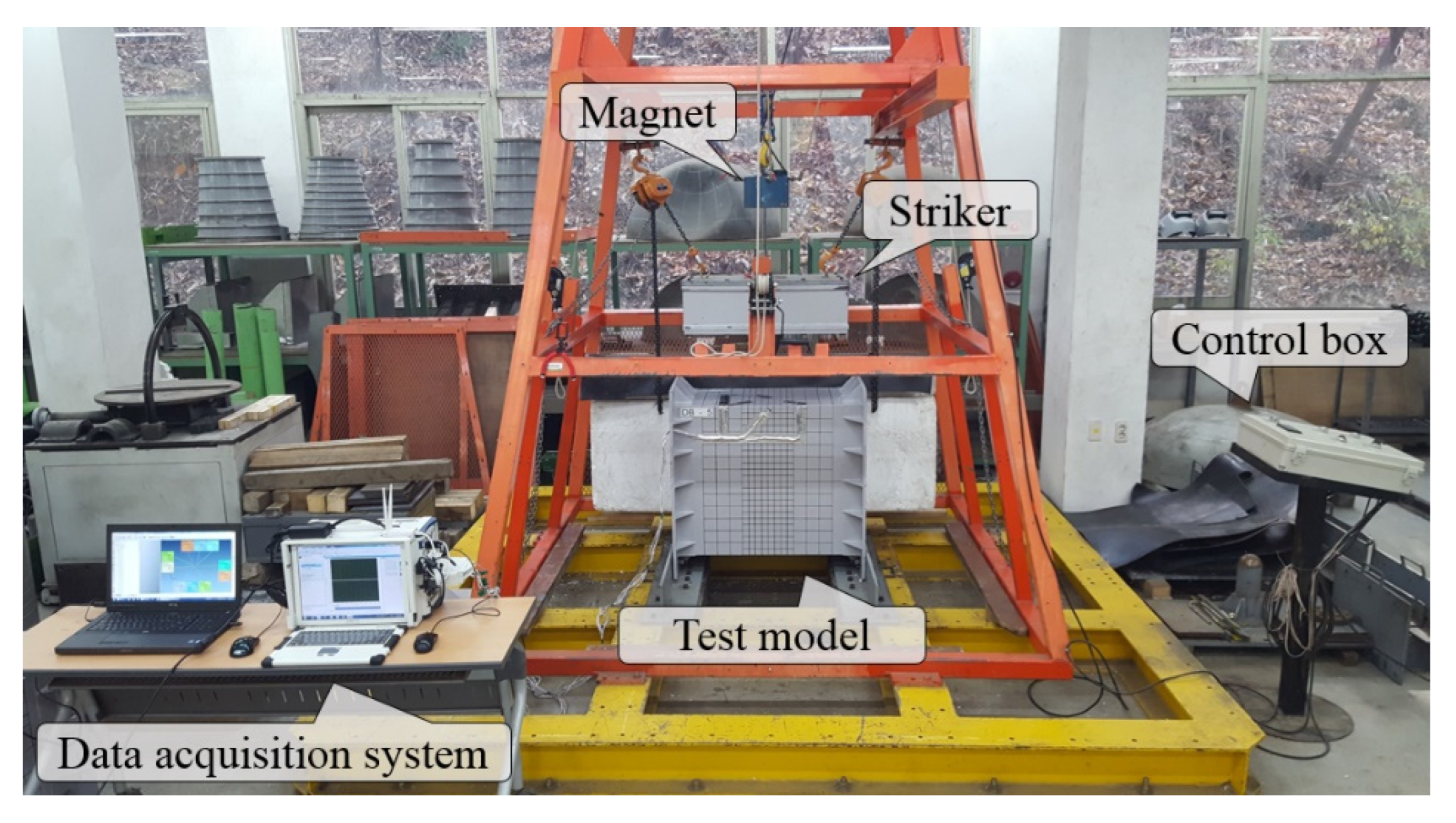
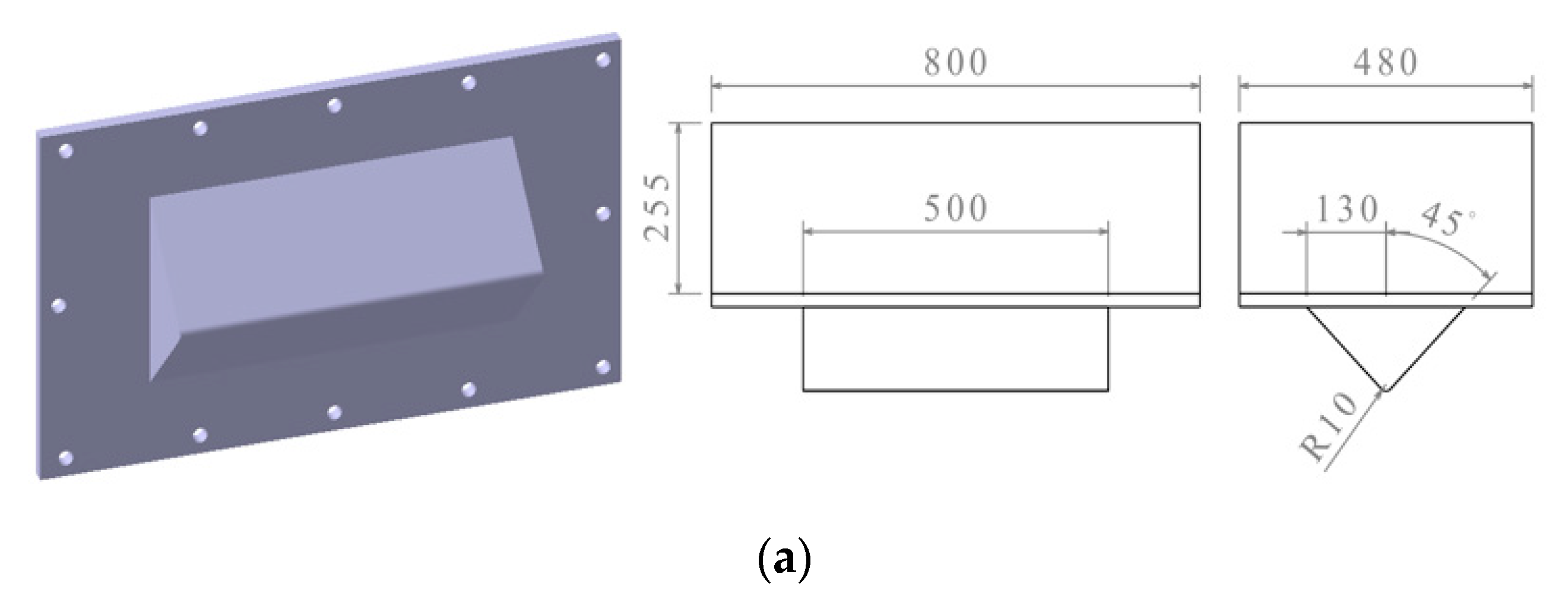
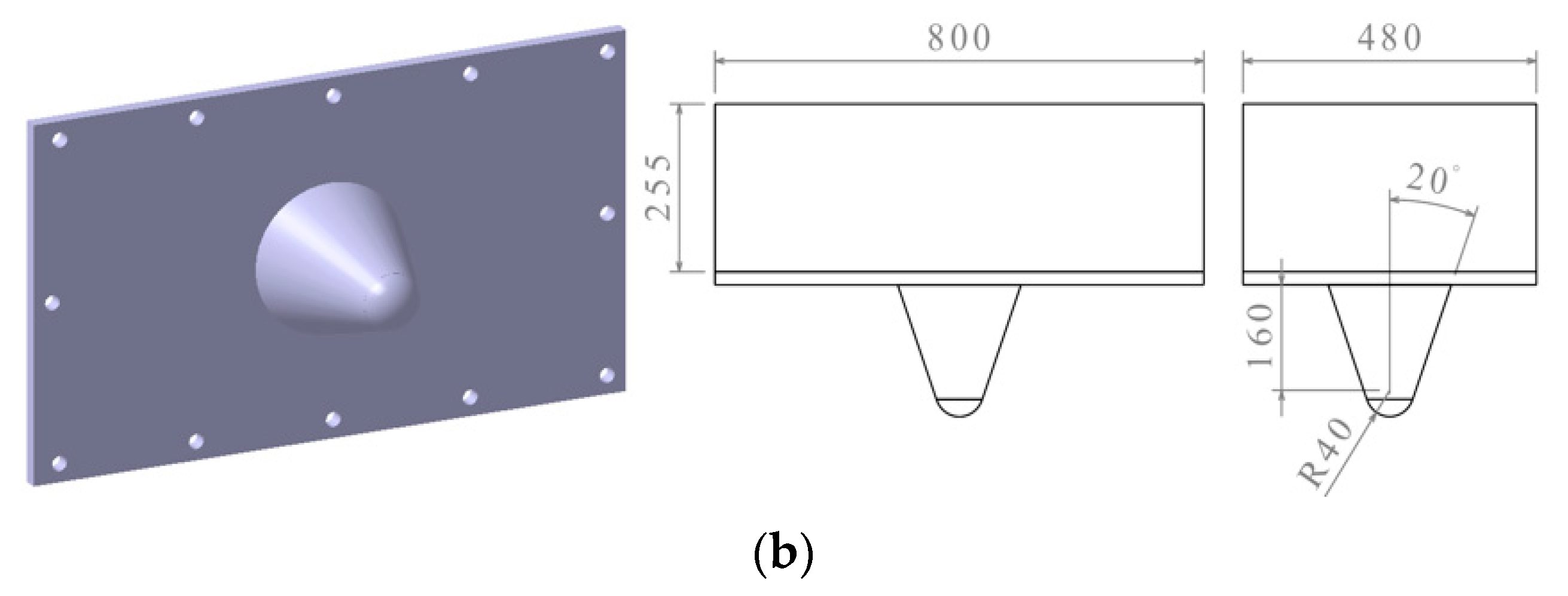
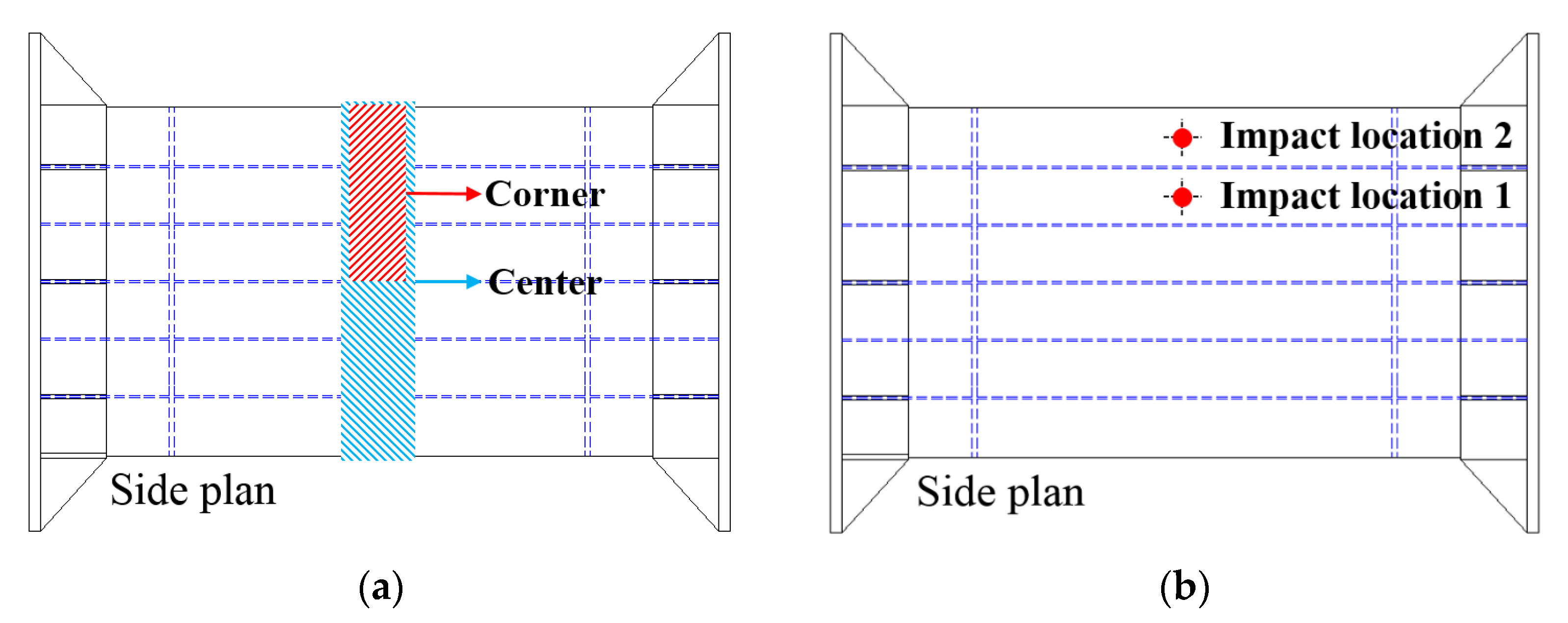
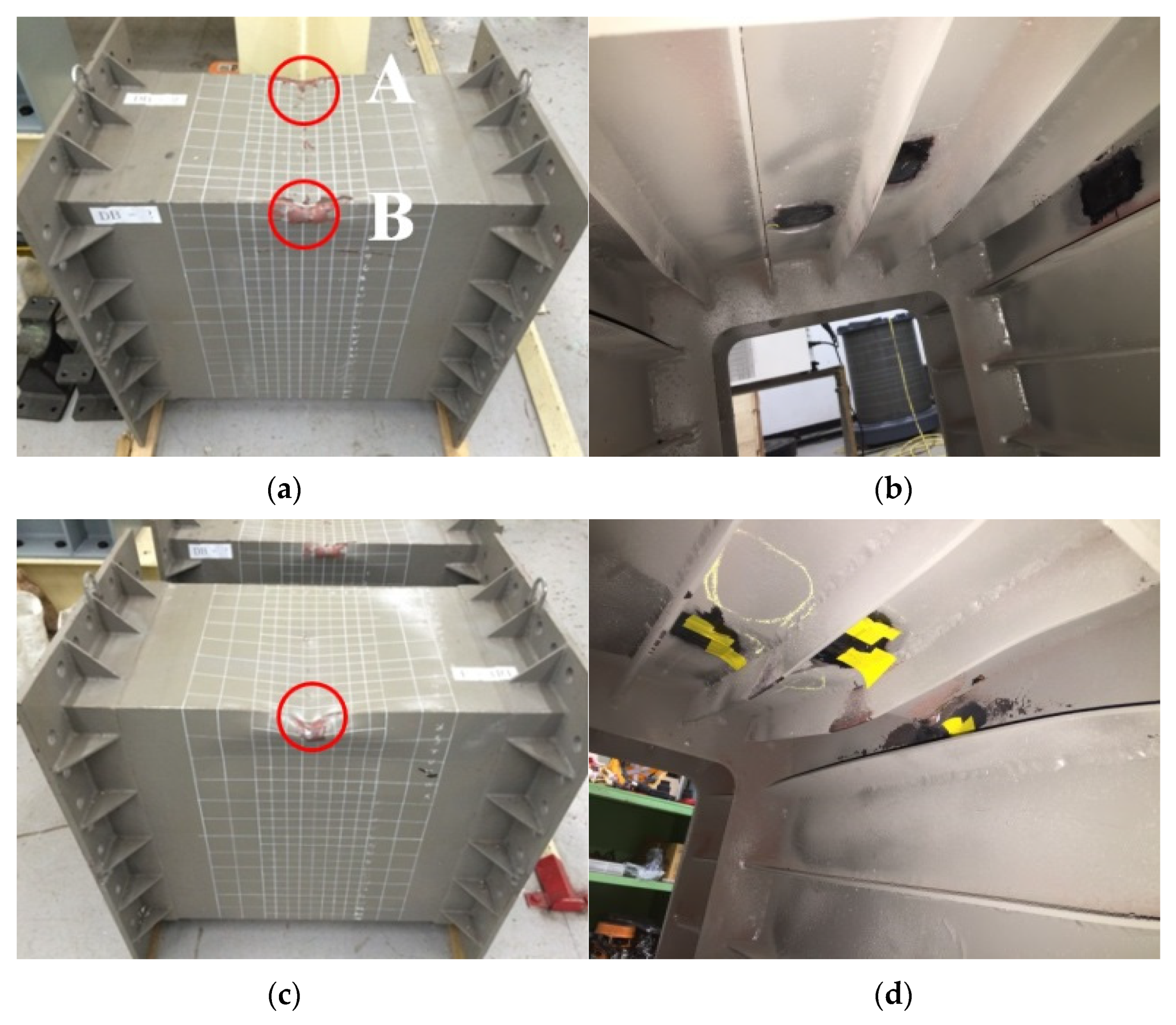
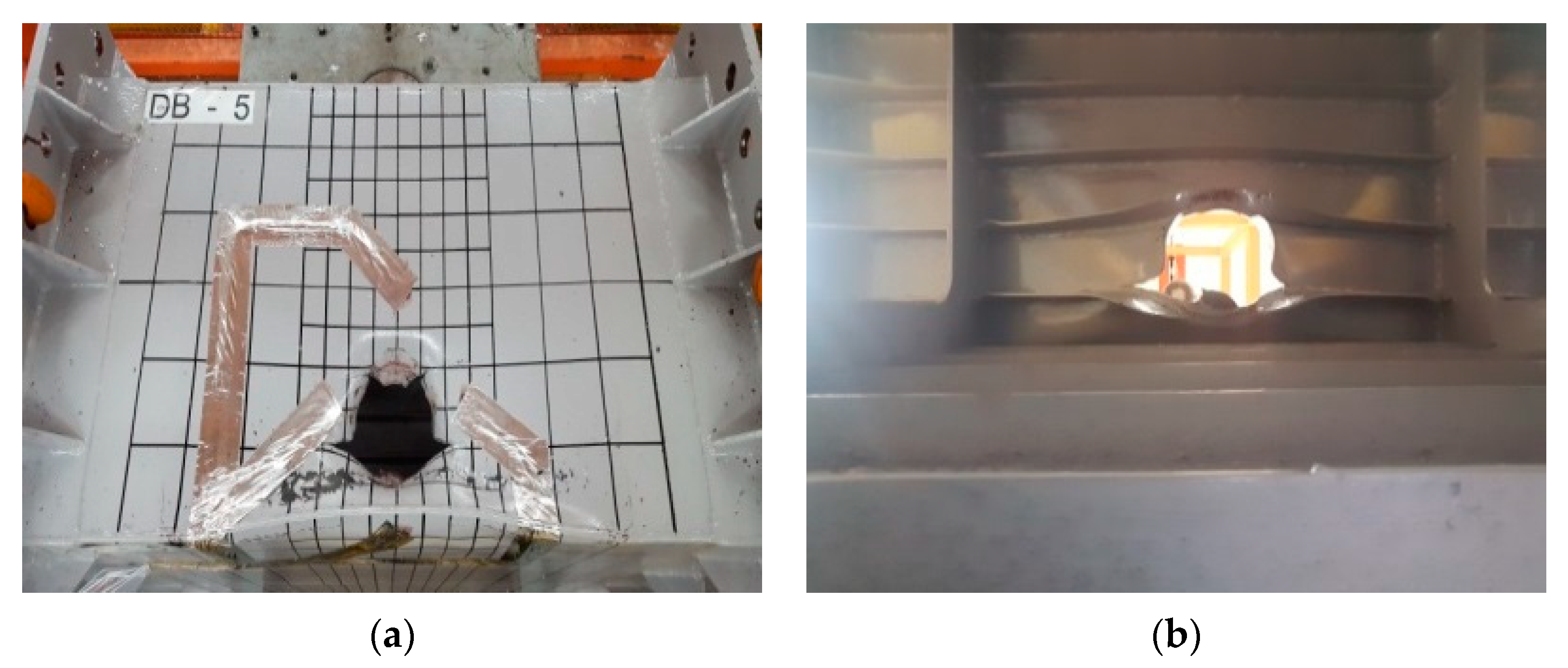
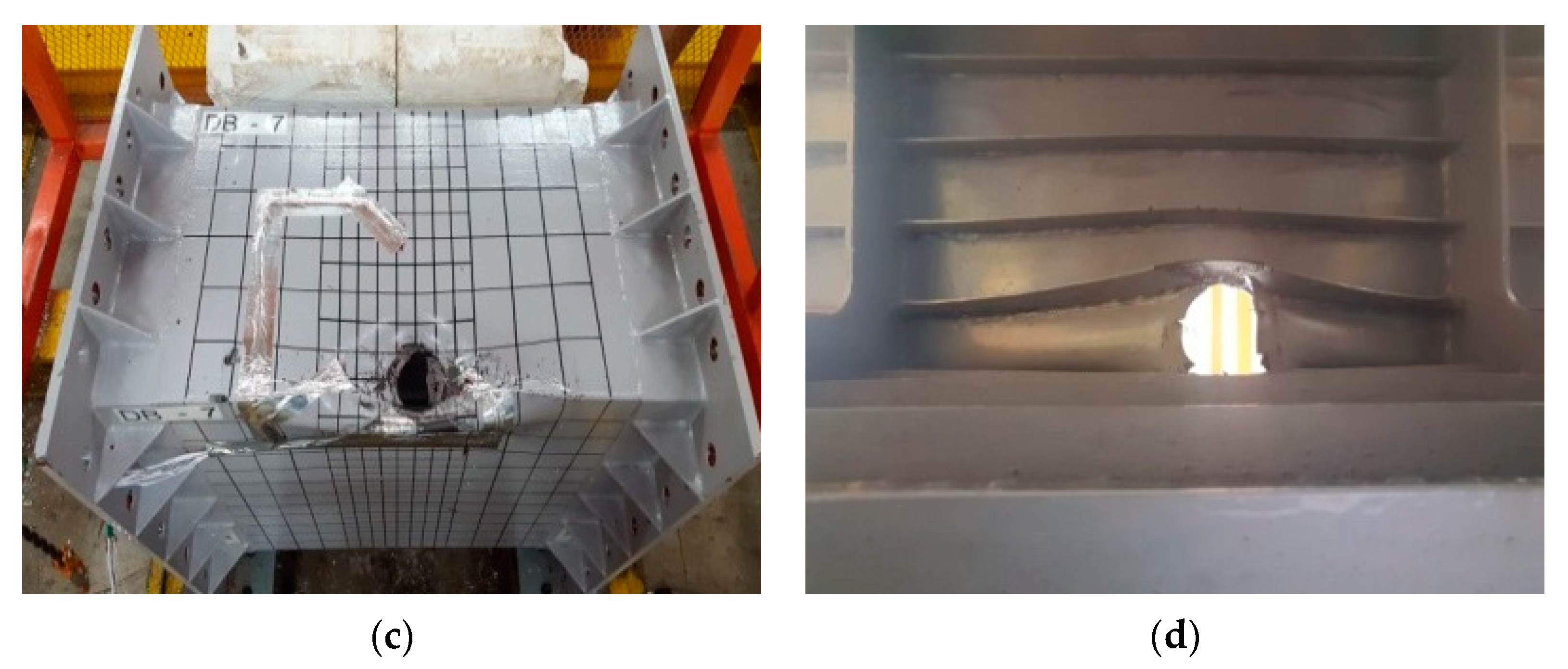
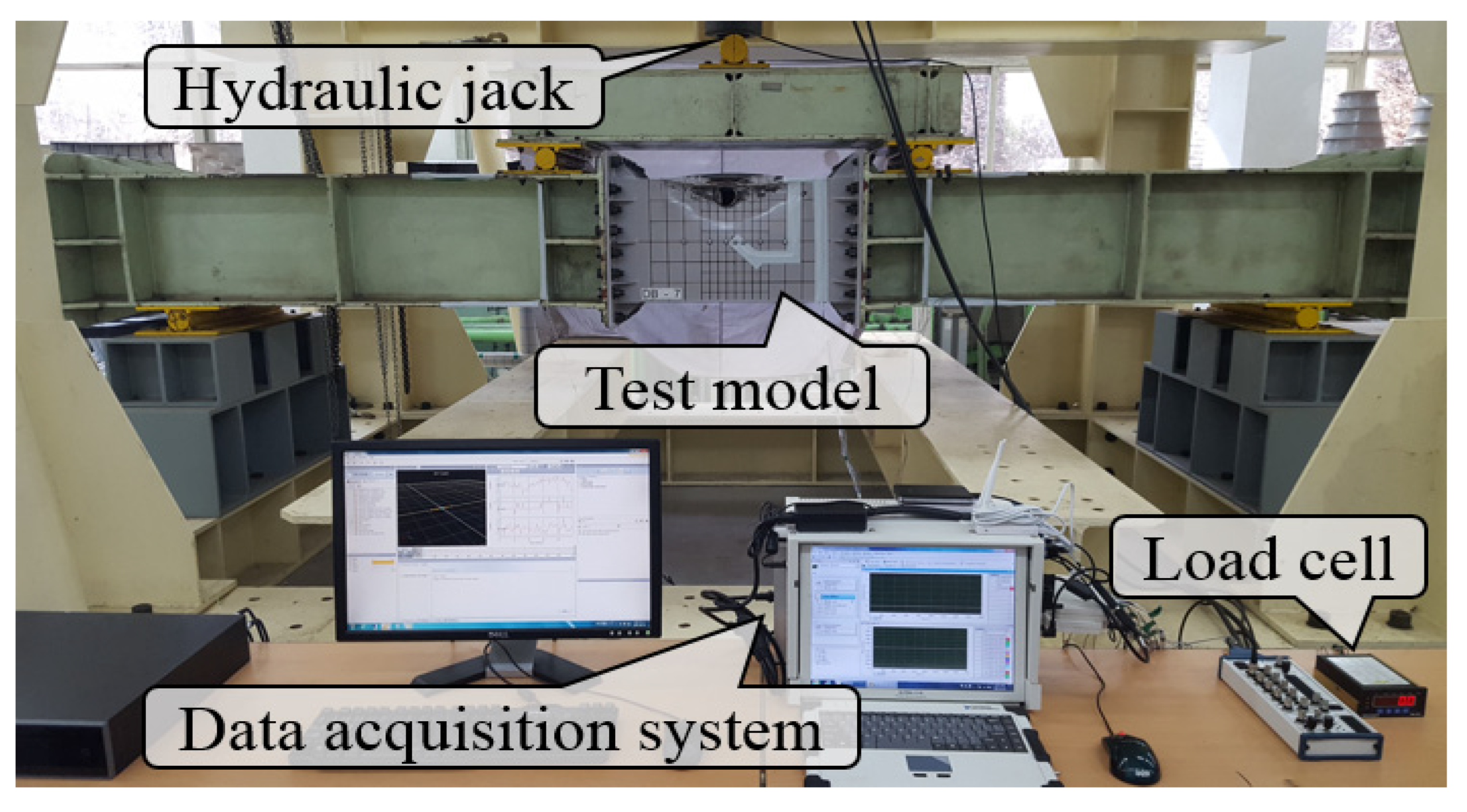
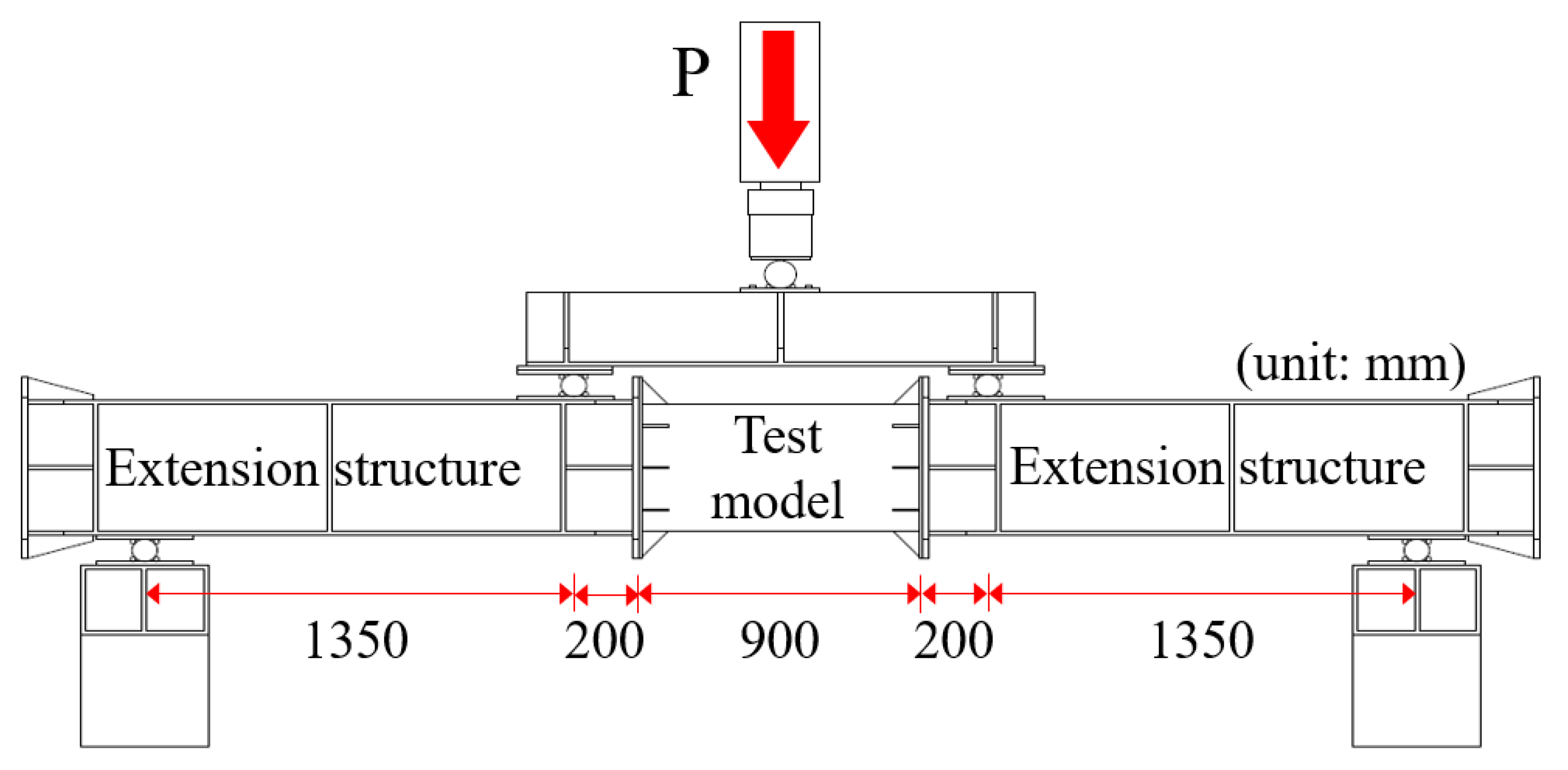
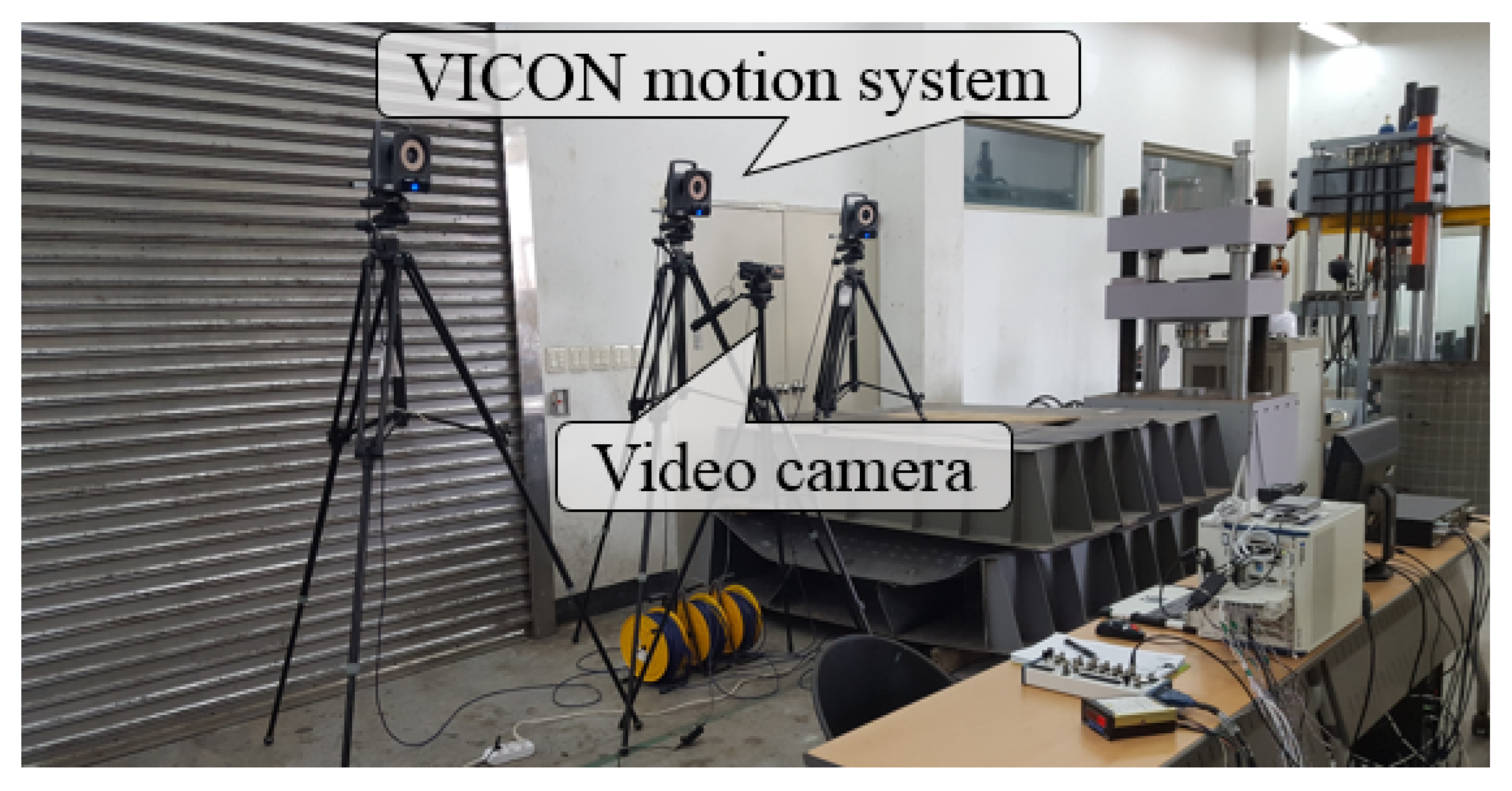
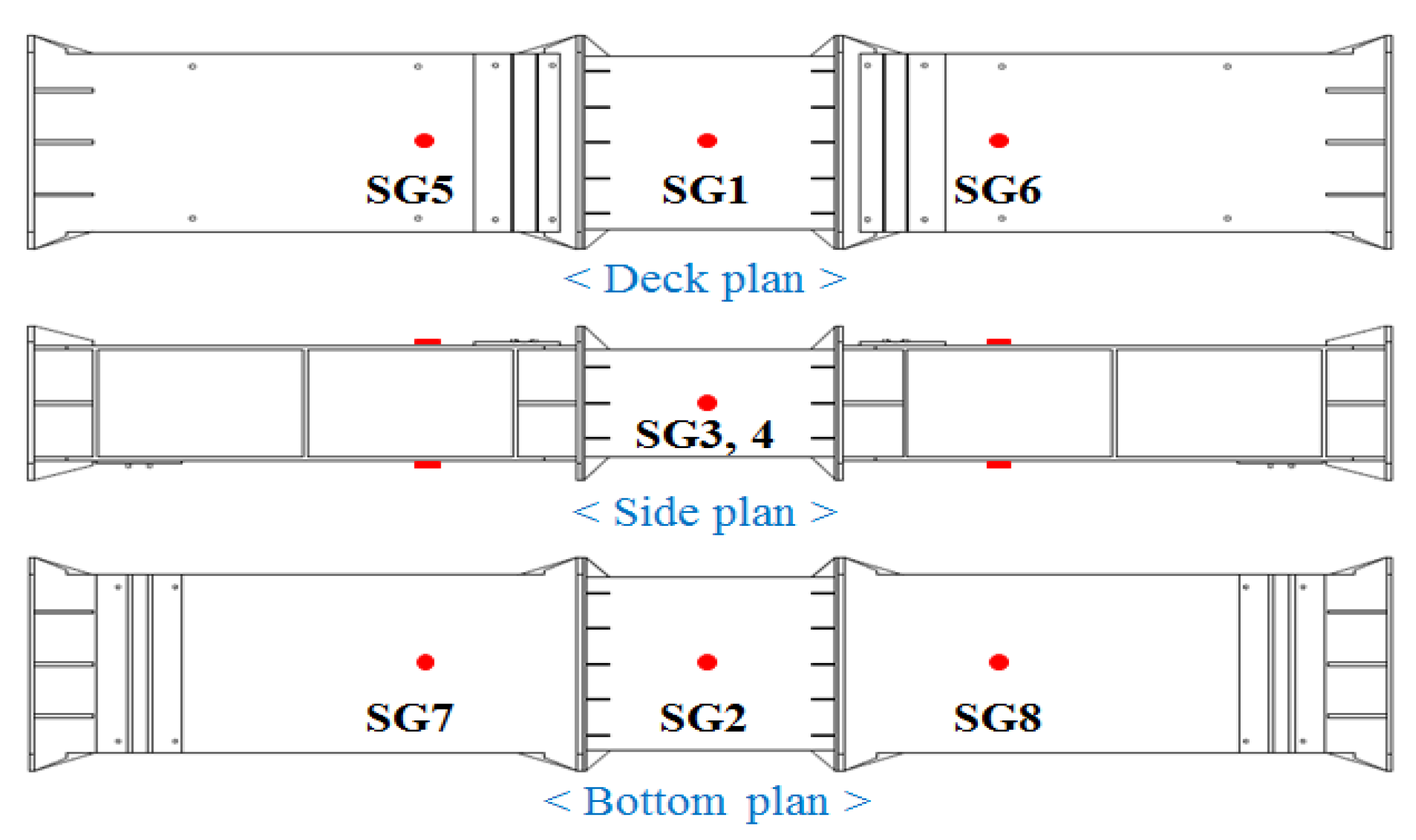

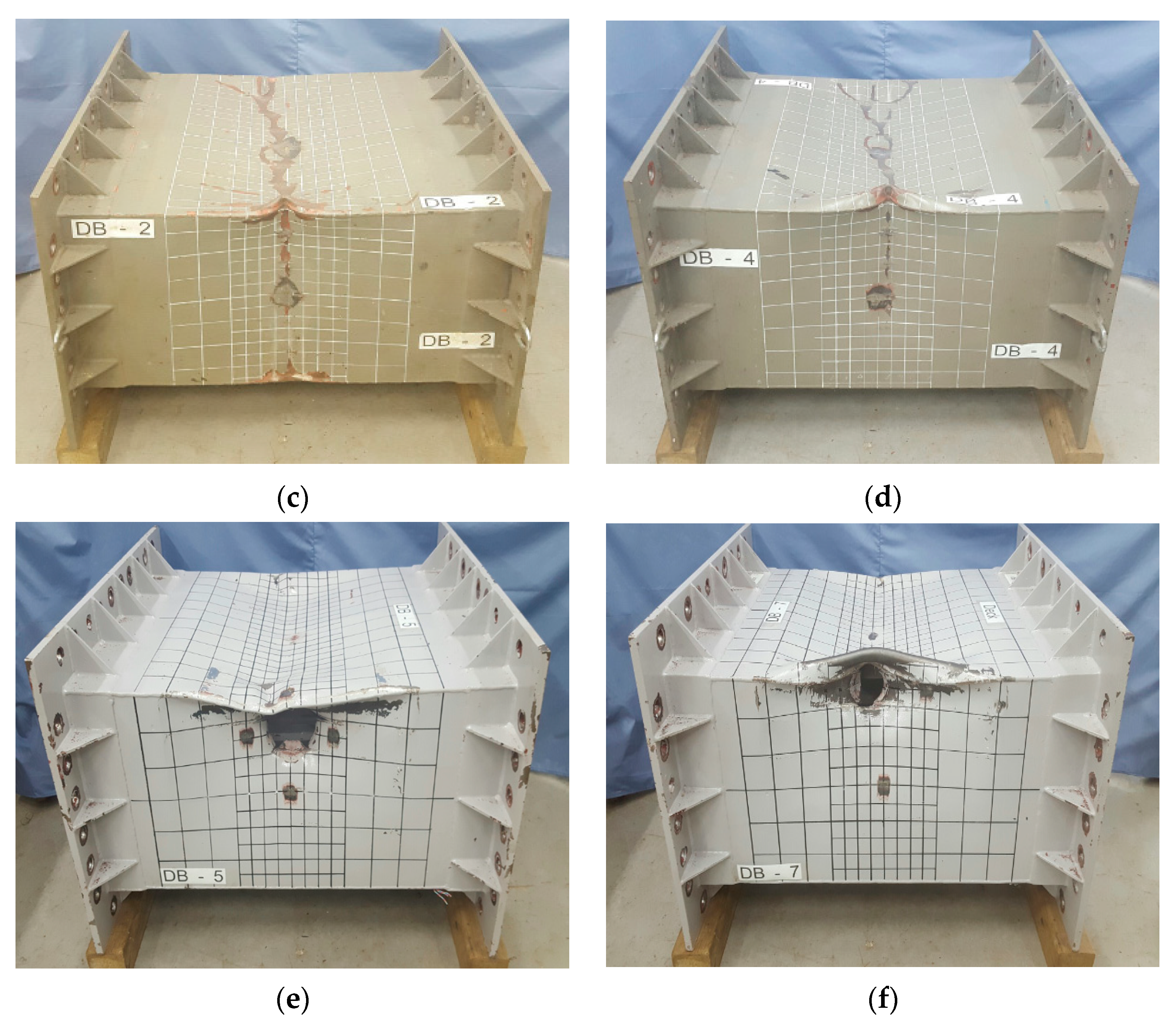
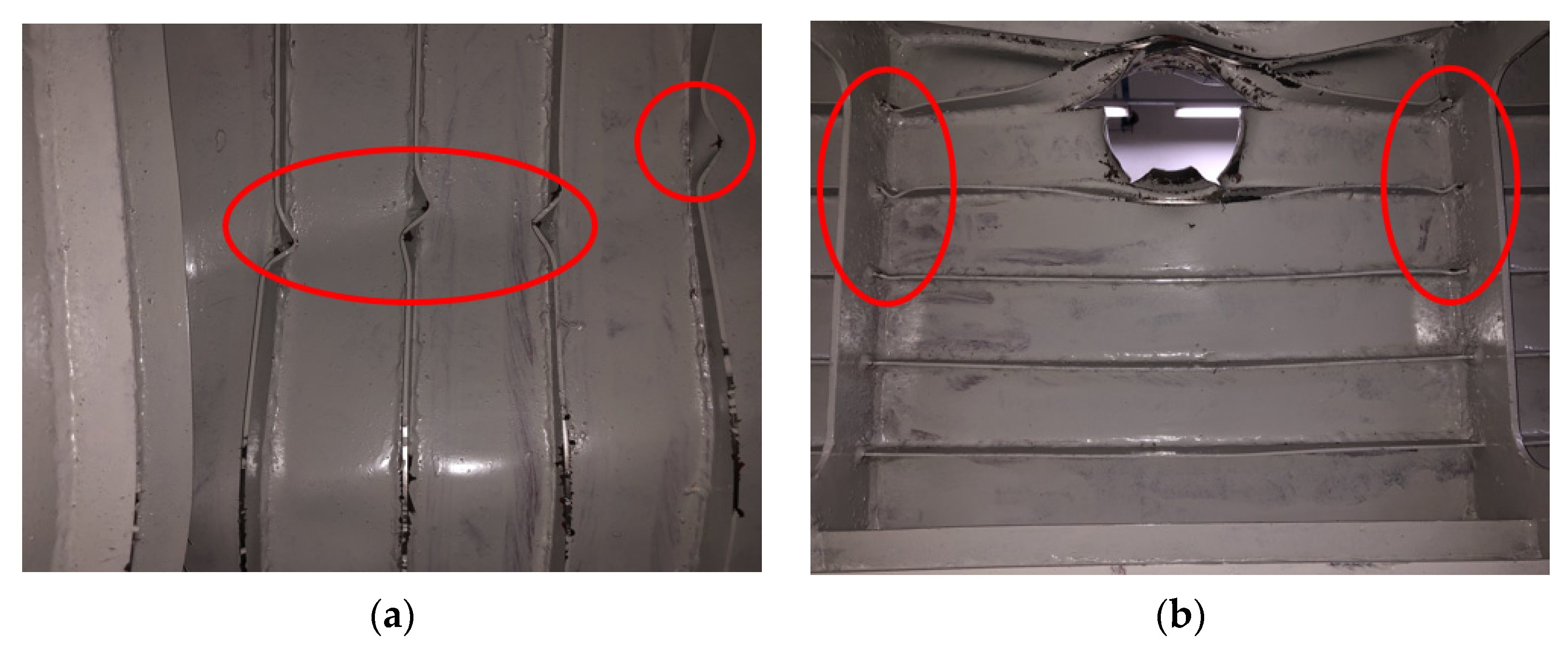
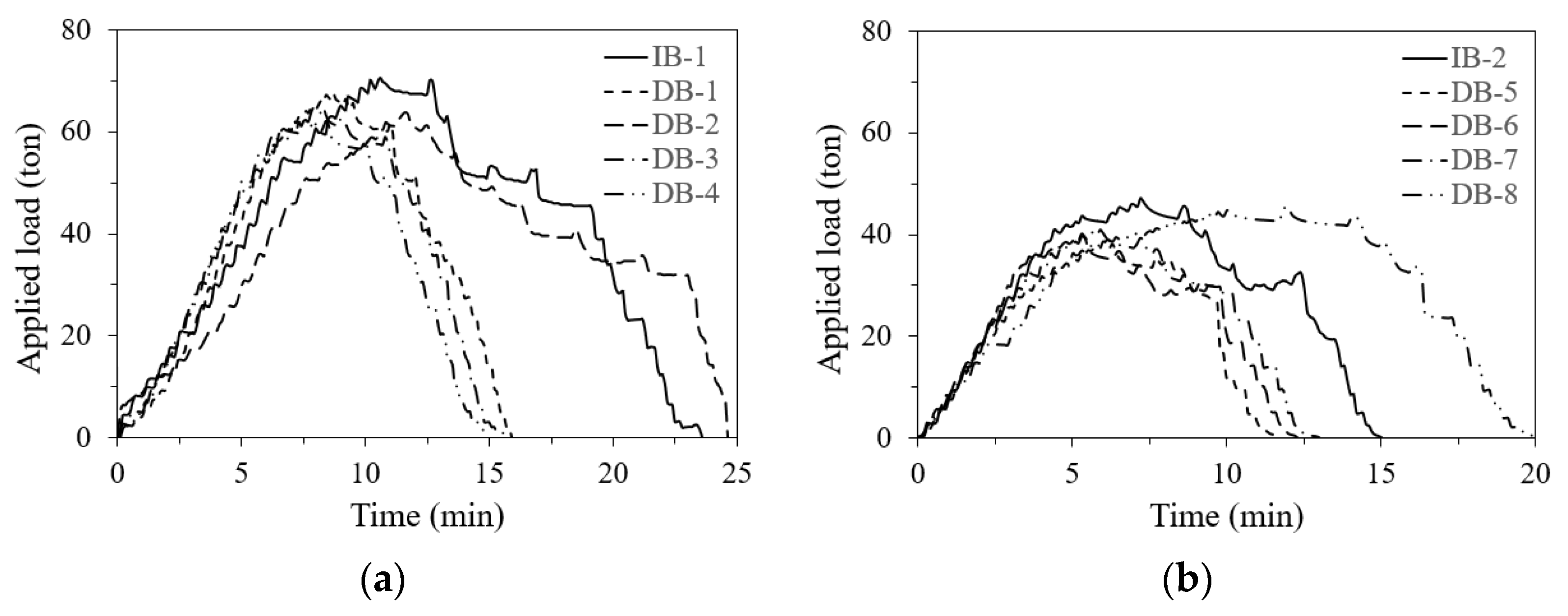

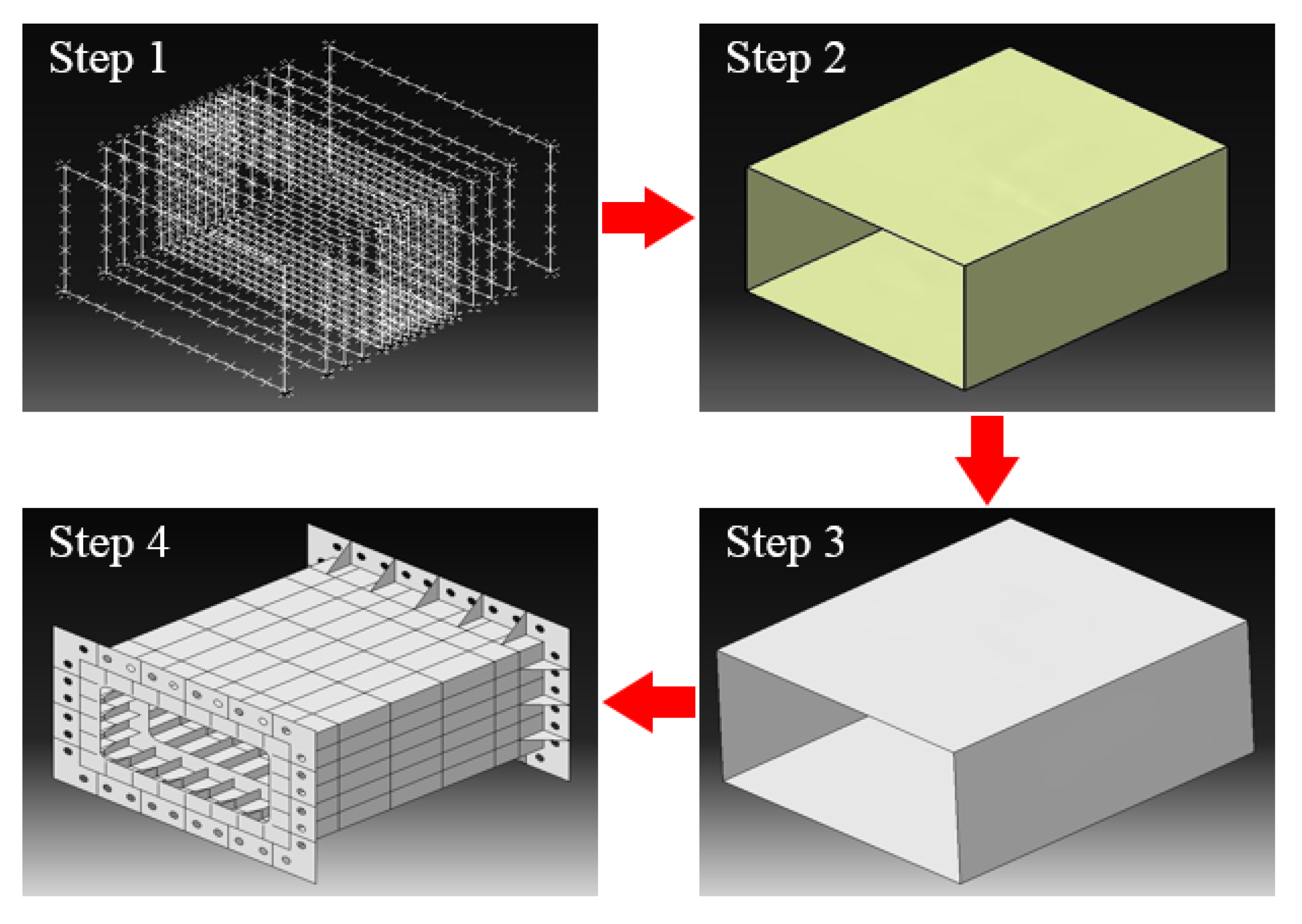
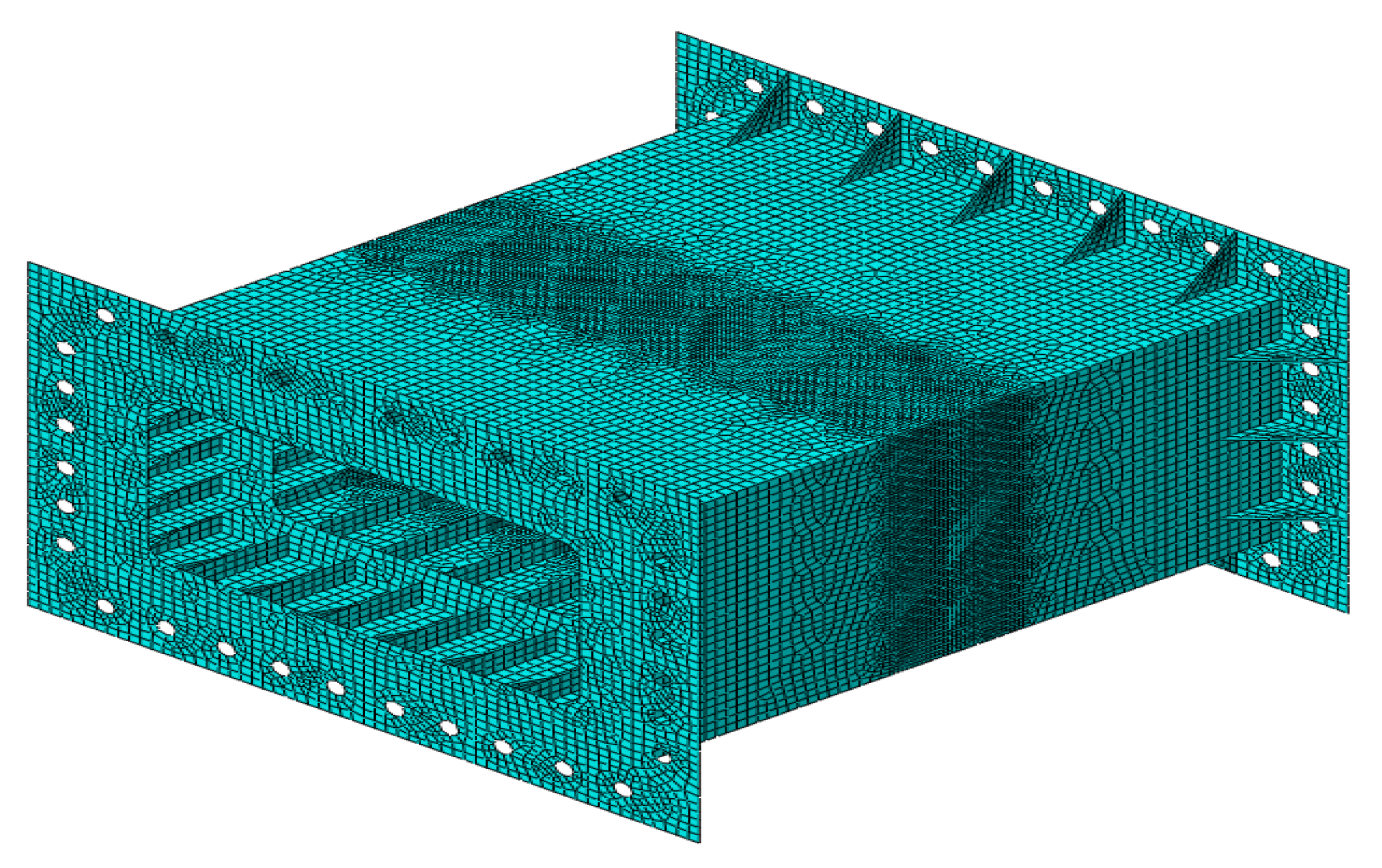

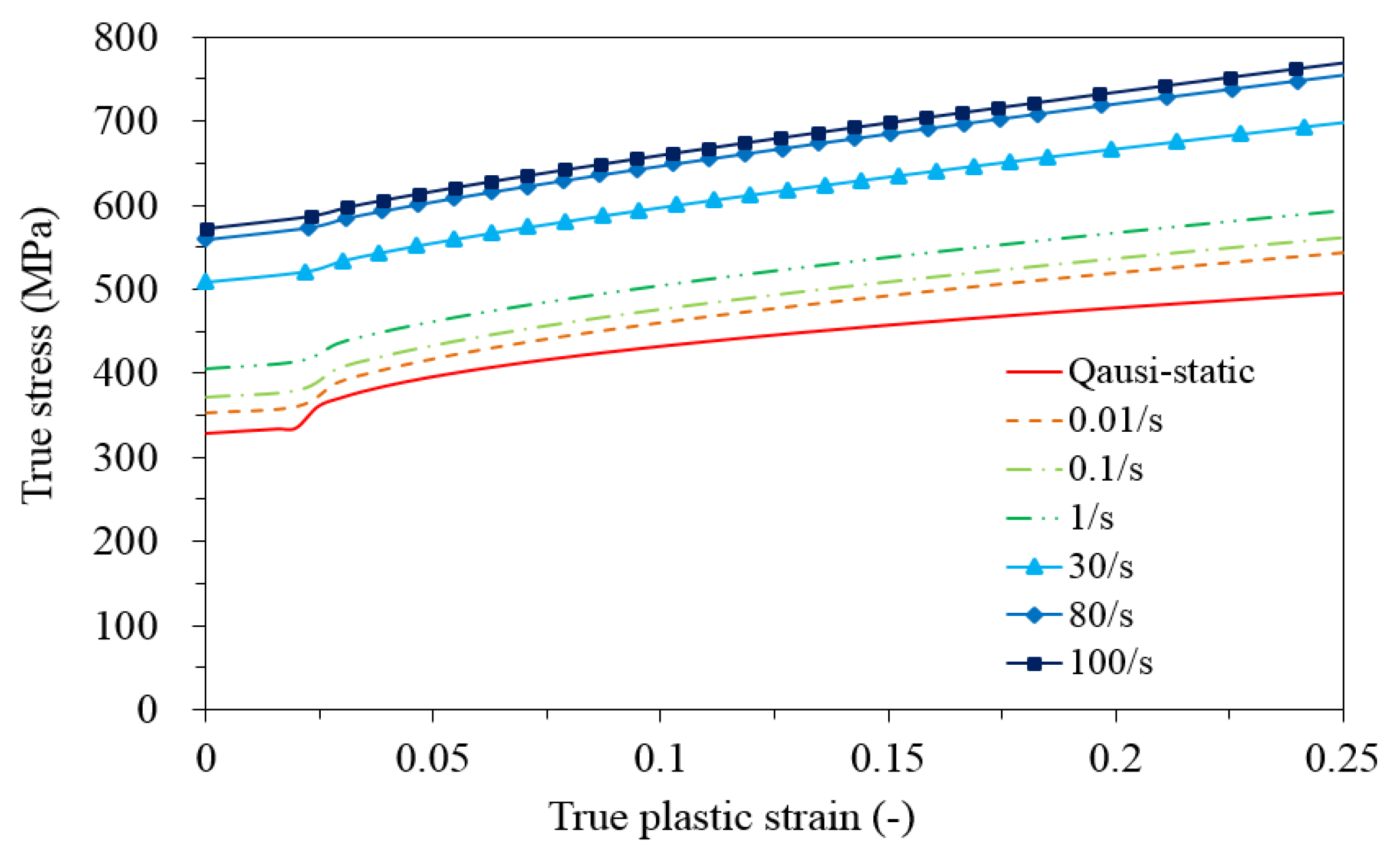
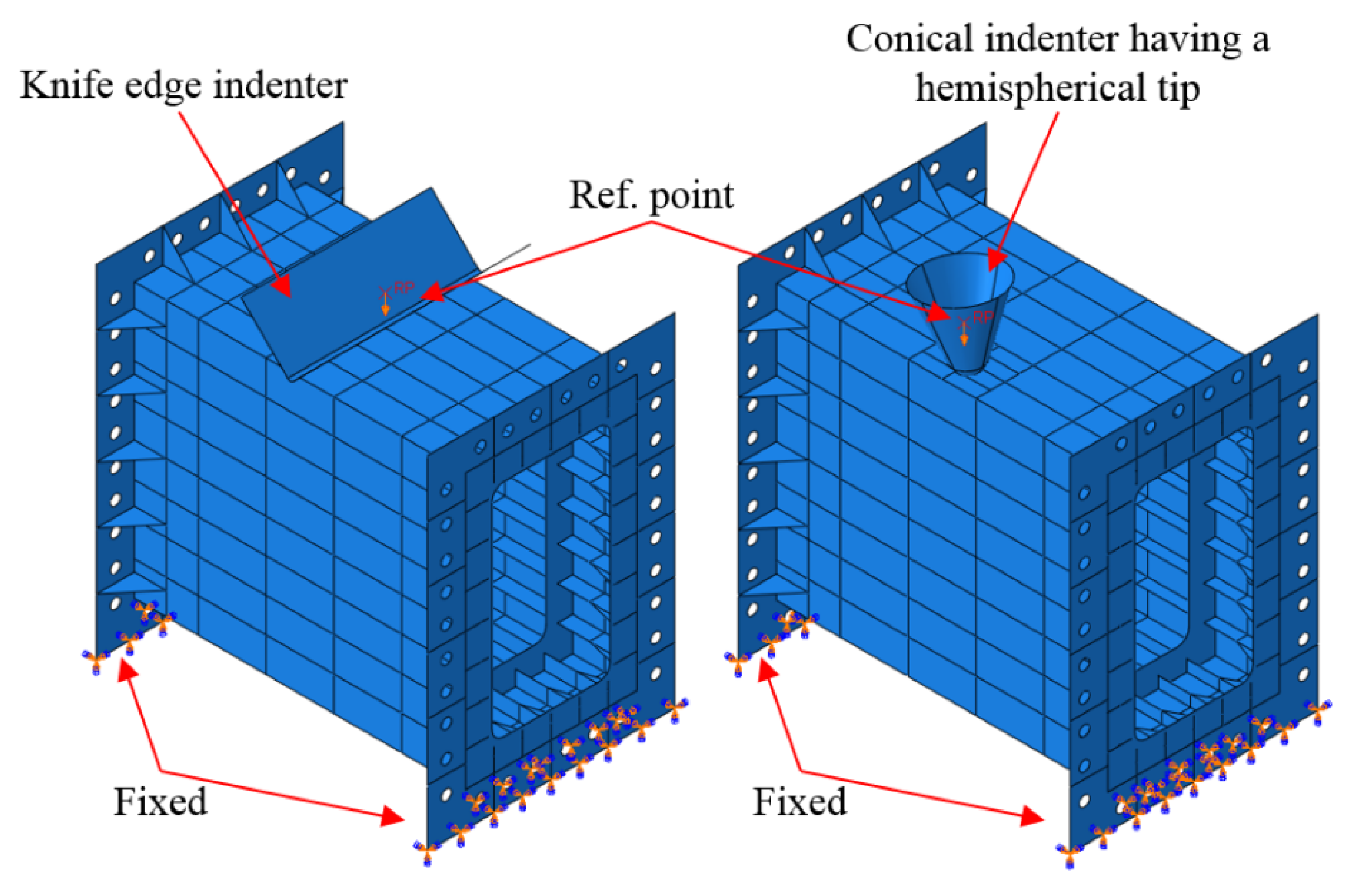
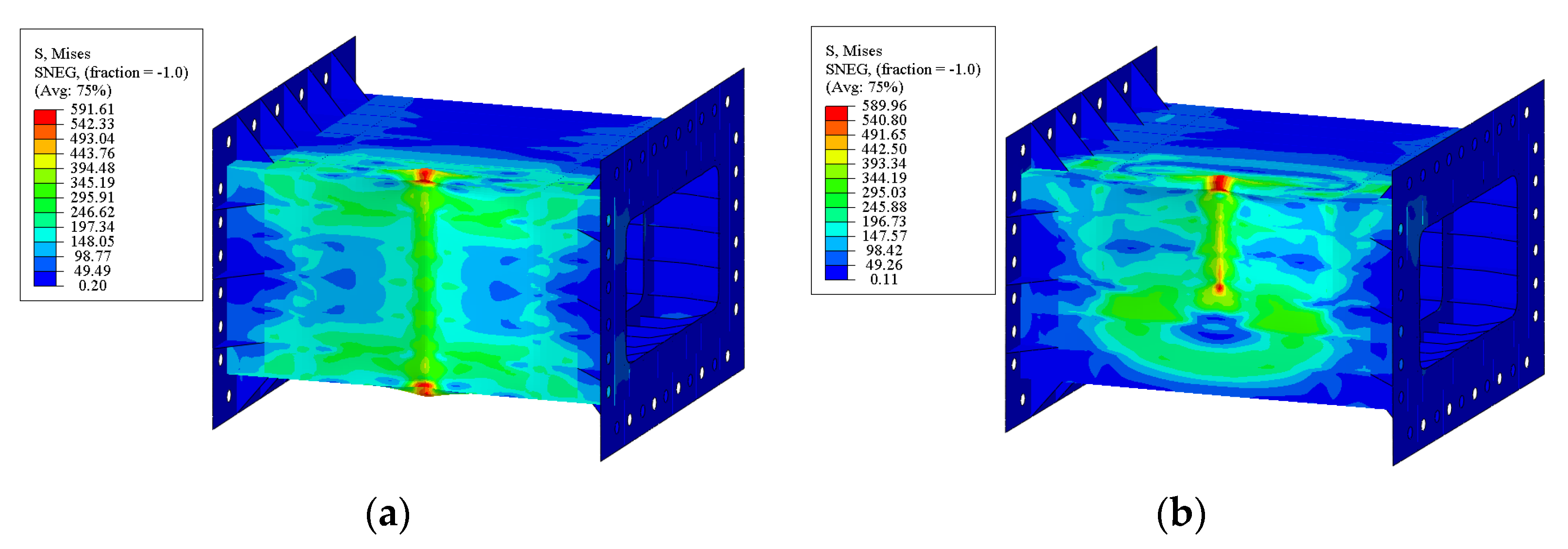

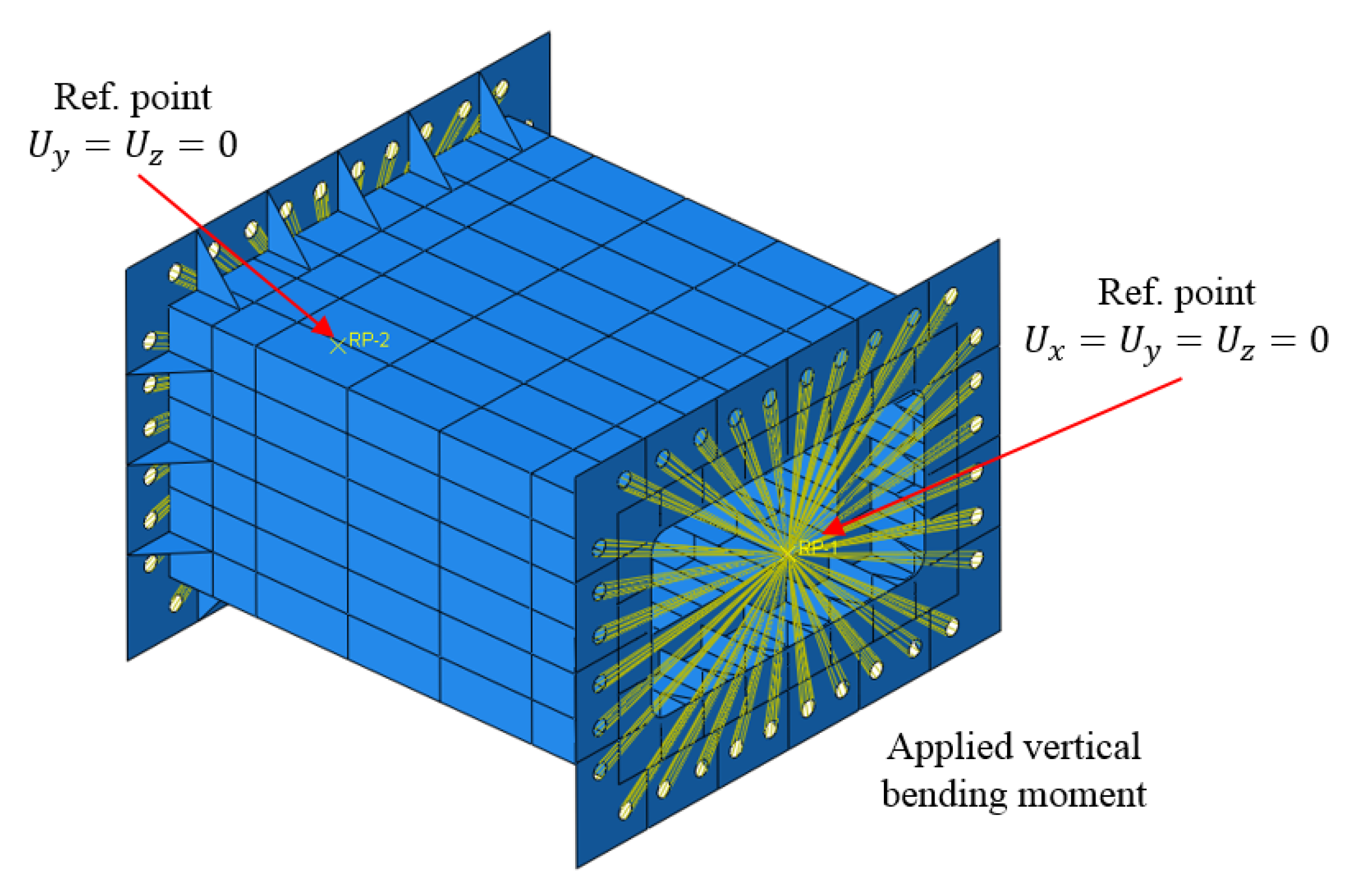
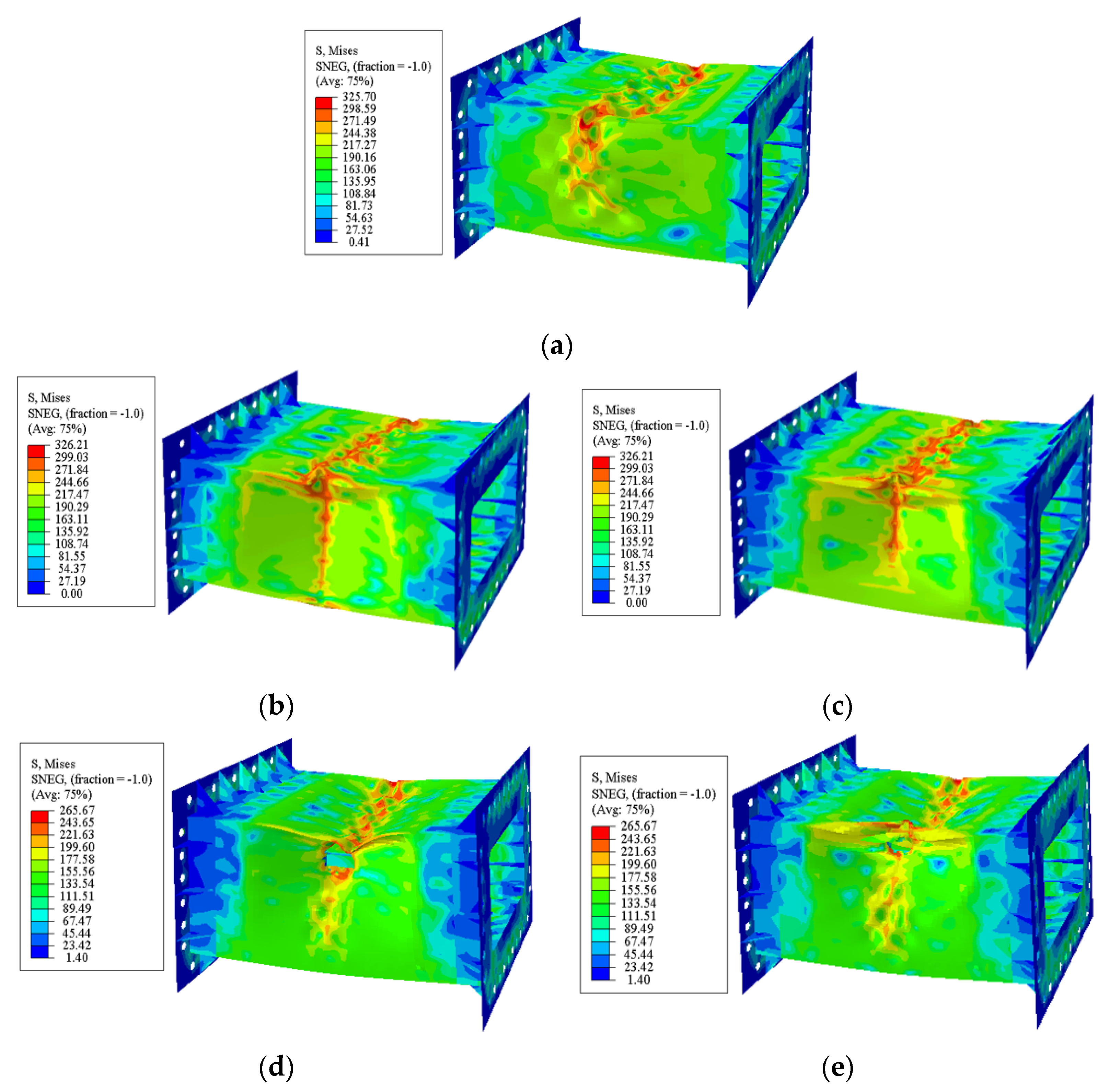
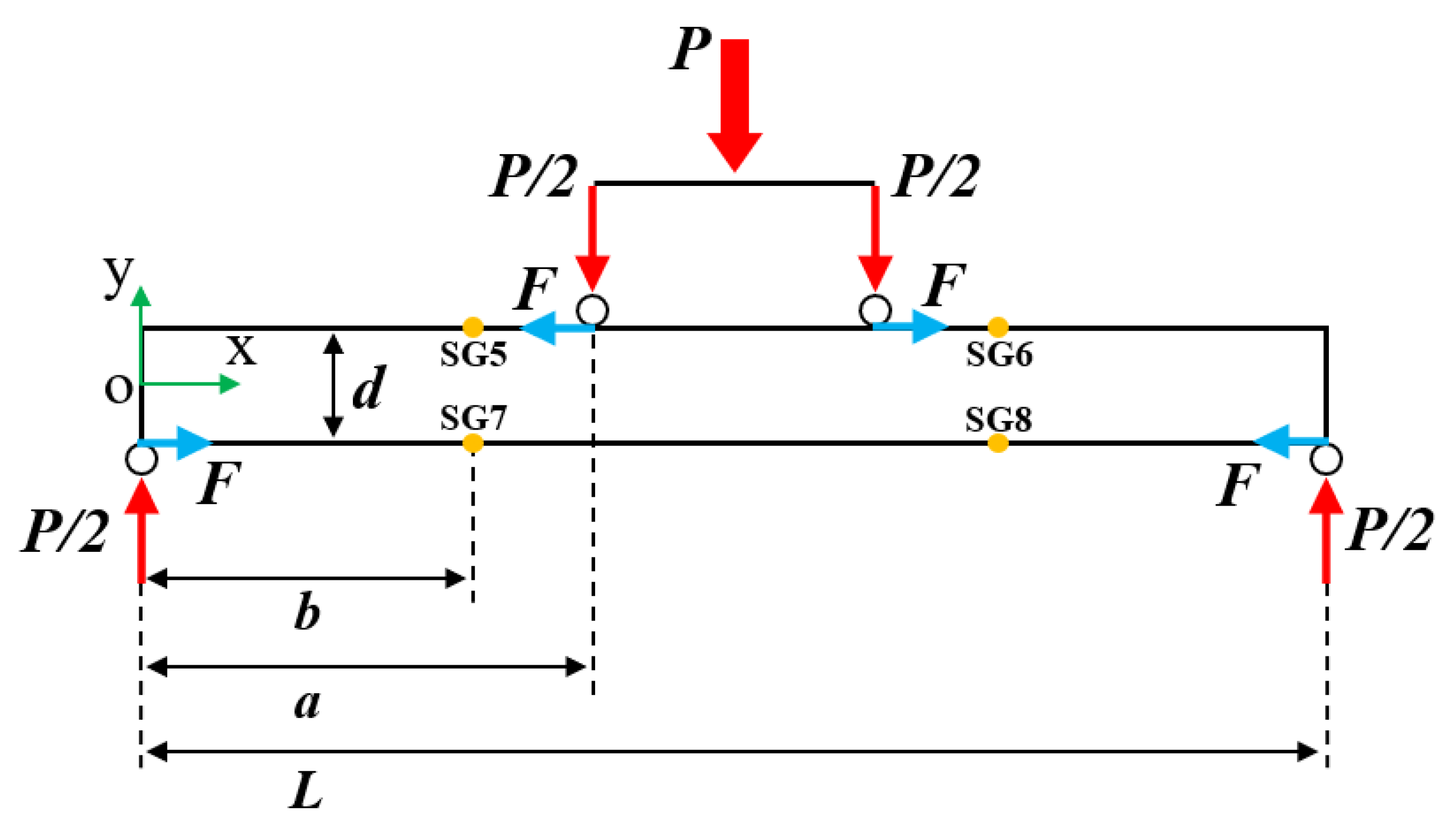
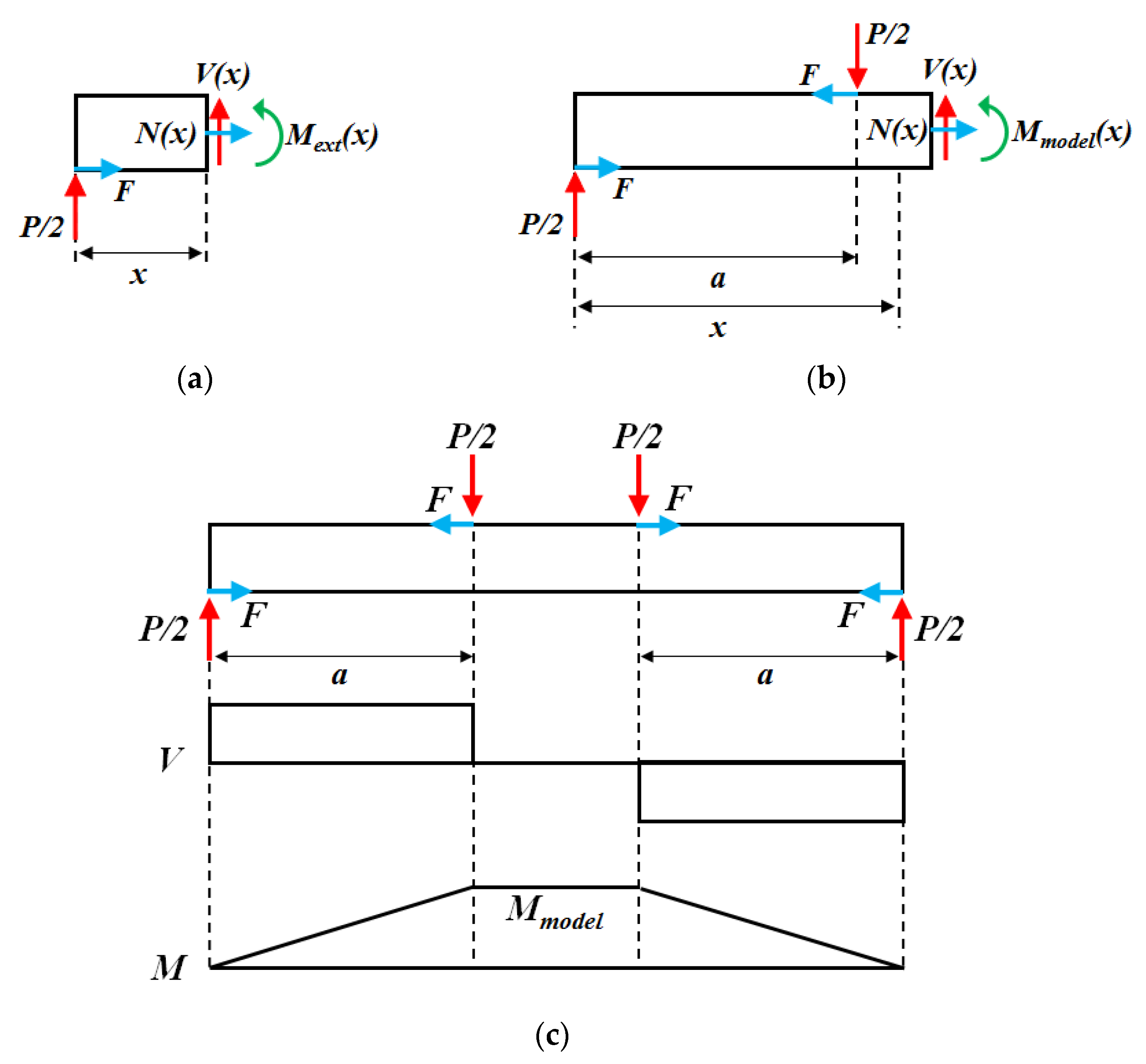
| Parent Plate | Actual Thick. (mm) | Young’s Modulus (MPa) | Yield Strength (MPa) | Ultimate Tensile Strength (MPa) | |||
|---|---|---|---|---|---|---|---|
| Mean | COV (%) | Mean | COV (%) | Mean | COV (%) | ||
| Group A | 2.91 | 205,000 | 2.76 | 325.7 | 0.28 | 399.2 | 0.15 |
| 5.88 | 207,000 | 1.25 | 234.8 | 1.84 | 353.4 | 0.52 | |
| Group B | 2.84 | 208,000 | 2.52 | 222.9 | 0.74 | 329.2 | 0.23 |
| 5.74 | 210,000 | 0.21 | 269.0 | 0.81 | 408.9 | 0.66 | |
| Model | Max. Positive Imperfection (mm) | Max. Negative Imperfection (mm) |
|---|---|---|
| IB-1 | 2.513 | 0.737 |
| DB-1 | 2.458 | 2.525 |
| DB-2 | 2.952 | 0.000 |
| DB-3 | 2.259 | 0.156 |
| DB-4 | 3.079 | 1.717 |
| IB-2 | 2.693 | 1.789 |
| DB-5 | 3.096 | 0.983 |
| DB-6 | 1.696 | 1.403 |
| DB-7 | 1.810 | 1.620 |
| DB-8 | 1.492 | 2.005 |
| Model | DB-1 | DB-2 | DB-3 | DB-4 |
|---|---|---|---|---|
| Impact location | Center | Center | Corner | Corner |
| Striker mass (kg) | 400 | 400 | 400 | 400 |
| Drop height (m) | 1.2 | 1.6 | 1.2 | 1.6 |
| Collision velocity (m/s) | 4.85 | 5.60 | 4.85 | 5.60 |
| Impact energy (kJ) | 4.71 | 6.28 | 4.71 | 6.28 |
| Permanent dent depth (mm) | 1 A: 22.4 B: 20.0 | A: 28.8 B: 23.6 | 31.6 | 44.9 |
| Model | DB-5 | DB-6 | DB-7 | DB-8 |
|---|---|---|---|---|
| Impact location | 1 | 1 | 2 | 2 |
| Striker mass (kg) | 570 | 570 | 570 | 570 |
| Drop height (m) | 1.9 | 1.6 | 1.9 | 1.6 |
| Collision velocity (m/s) | 6.11 | 5.60 | 6.11 | 5.60 |
| Impact energy (kJ) | 10.62 | 8.95 | 10.62 | 8.95 |
| Diagonal length (mm) | 137.6 | 87.3 | 78.1 | 74.4 |
| Group A Stiffened Web Height = 40 mm Yield Strength = 325.7 MPa | Group B Stiffened Web Height = 30 mm Yield Strength = 222.9 MPa | ||||
|---|---|---|---|---|---|
| Model | Permanent Dent Depth (mm) | Max. Load (ton) | Model | Diagonal Fracture Length (mm) | Max. Load (ton) |
| IB-1 | - | 70.5 | IB-2 | - | 47.0 |
| DB-1 | 22.4 | 67.5 | DB-5 | 137.6 | 38.6 |
| DB-2 | 28.8 | 63.8 | DB-6 | 87.3 | 40.2 |
| DB-3 | 31.6 | 64.8 | DB-7 | 78.1 | 41.0 |
| DB-4 | 44.9 | 62.3 | DB-8 | 74.4 | 45.4 |
| Model | Permanent Dent Depth (mm) | Xm (Num./Exp.) | |
|---|---|---|---|
| Experiment | Numerical | ||
| DB-1 | 22.4 | 25.3 | 1.13 |
| DB-2 | 28.8 | 30.4 | 1.06 |
| DB-3 | 31.6 | 33.0 | 1.04 |
| DB-4 | 44.9 | 47.6 | 1.06 |
| Mean | 1.07 | ||
| COV | 3.60% | ||
| Model | Mesh Size/Thickness | Shear Criterion |
|---|---|---|
| DB-5 | 2 | 0.23 |
| DB-6 | 0.27 | |
| DB-7 | 0.27 | |
| DB-8 | 0.23 |
| Model | Diagonal Length (mm) | Xm (Num./Exp.) | |
|---|---|---|---|
| Experiment | Numerical | ||
| DB-5 | 137.6 | 144.5 | 1.05 |
| DB-6 | 87.3 | 90.8 | 1.04 |
| DB-7 | 78.1 | 79.7 | 1.02 |
| DB-8 | 74.4 | 77.5 | 1.04 |
| Mean | 1.04 | ||
| COV | 1.23% | ||
| Model | Ultimate Bending Moment, Mult (kN·m) | Xm (2)/(1) | |
|---|---|---|---|
| Neglecting Friction (1) | Considering Friction (2) | ||
| IB-1 | 466.8 | 397.2 | 0.85 |
| DB-1 | 447.0 | 390.8 | 0.87 |
| DB-2 | 422.1 | 368.5 | 0.87 |
| DB-3 | 430.6 | 353.1 | 0.82 |
| DB-4 | 416.6 | 346.0 | 0.83 |
| IB-2 | 313.1 | 283.0 | 0.90 |
| DB-5 | 257.4 | 240.8 | 0.94 |
| DB-6 | 267.4 | 256.8 | 0.96 |
| DB-7 | 273.1 | 245.2 | 0.90 |
| DB-8 | 301.0 | 267.6 | 0.89 |
| Mean | 0.88 | ||
| COV | 4.97% | ||
| Model | Ultimate Bending Moment (kN·m) | Xm1 (Exp. (1)/Num.) | Xm2 (Exp. (2)/Num.) | ||
|---|---|---|---|---|---|
| Exp. (1) 1 | Exp. (2) 2 | Num.3 | |||
| IB-1 | 466.8 | 397.2 | 501.6 | 0.93 | 0.79 |
| DB-1 | 447.0 | 390.8 | 446.6 | 1.00 | 0.88 |
| DB-2 | 422.1 | 368.5 | 438.9 | 0.96 | 0.84 |
| DB-3 | 430.6 | 353.1 | 457.5 | 0.94 | 0.77 |
| DB-4 | 416.6 | 346.0 | 441.7 | 0.94 | 0.78 |
| IB-2 | 313.1 | 283.0 | 319.2 | 0.98 | 0.89 |
| DB-5 | 257.4 | 240.8 | 267.1 | 0.96 | 0.90 |
| DB-6 | 267.4 | 256.8 | 273.9 | 0.98 | 0.94 |
| DB-7 | 273.1 | 245.2 | 286.2 | 0.95 | 0.86 |
| DB-8 | 301.0 | 267.6 | 305.1 | 0.99 | 0.88 |
| Mean | 0.96 | 0.85 | |||
| COV | 2.31% | 6.44% | |||
| Model | Impact Energy (kJ) | Dent Depth (mm) | Mult (kN·m) | Reduction of Mult (kN·m) |
|---|---|---|---|---|
| IB-1 | - | - | 397.2 | - |
| DB-1 | 4.71 | 22.4 | 390.8 | 6.4 (1.6%) |
| DB-2 | 6.28 | 28.8 | 368.5 | 28.7 (7.2%) |
| DB-3 | 4.71 | 31.6 | 353.1 | 44.1 (11.1%) |
| DB-4 | 6.28 | 44.9 | 346.0 | 51.2 (12.9%) |
| Model | Impact Energy (kJ) | Diagonal Length (mm) | Mult (kN·m) | Reduction of Mult (kN·m) |
|---|---|---|---|---|
| IB-2 | - | - | 283.0 | - |
| DB-5 | 10.62 | 137.6 | 240.8 | 42.2 (14.9%) |
| DB-6 | 8.95 | 87.3 | 256.8 | 26.2 (9.3%) |
| DB-7 | 10.62 | 78.1 | 245.2 | 37.8 (13.4%) |
| DB-8 | 8.95 | 74.4 | 267.6 | 15.4 (5.4%) |
Disclaimer/Publisher’s Note: The statements, opinions and data contained in all publications are solely those of the individual author(s) and contributor(s) and not of MDPI and/or the editor(s). MDPI and/or the editor(s) disclaim responsibility for any injury to people or property resulting from any ideas, methods, instructions or products referred to in the content. |
© 2023 by the authors. Licensee MDPI, Basel, Switzerland. This article is an open access article distributed under the terms and conditions of the Creative Commons Attribution (CC BY) license (https://creativecommons.org/licenses/by/4.0/).
Share and Cite
Park, S.-H.; Yoon, S.-H.; Muttaqie, T.; Do, Q.T.; Cho, S.-R. Effects of Local Denting and Fracture Damage on the Residual Longitudinal Strength of Box Girders. J. Mar. Sci. Eng. 2023, 11, 76. https://doi.org/10.3390/jmse11010076
Park S-H, Yoon S-H, Muttaqie T, Do QT, Cho S-R. Effects of Local Denting and Fracture Damage on the Residual Longitudinal Strength of Box Girders. Journal of Marine Science and Engineering. 2023; 11(1):76. https://doi.org/10.3390/jmse11010076
Chicago/Turabian StylePark, Sang-Hyun, Sang-Hoon Yoon, Teguh Muttaqie, Quang Thang Do, and Sang-Rai Cho. 2023. "Effects of Local Denting and Fracture Damage on the Residual Longitudinal Strength of Box Girders" Journal of Marine Science and Engineering 11, no. 1: 76. https://doi.org/10.3390/jmse11010076








